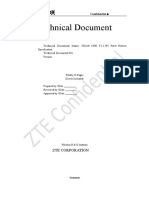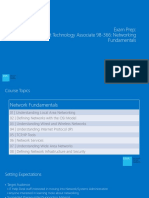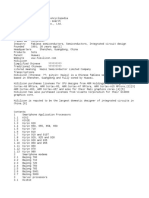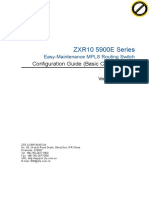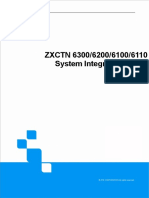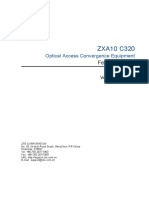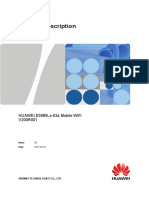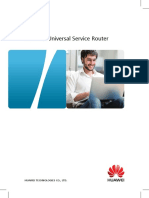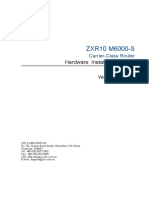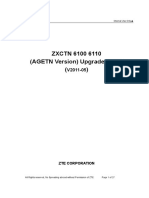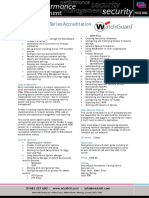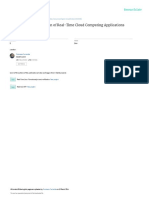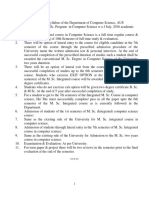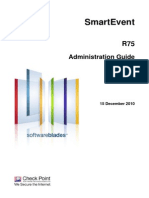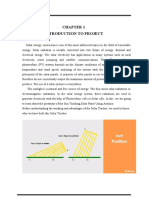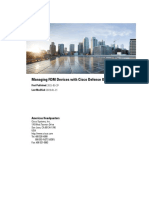zxr10 m6000 PDF
zxr10 m6000 PDF
Uploaded by
reimy ortizCopyright:
Available Formats
zxr10 m6000 PDF
zxr10 m6000 PDF
Uploaded by
reimy ortizOriginal Title
Copyright
Available Formats
Share this document
Did you find this document useful?
Is this content inappropriate?
Copyright:
Available Formats
zxr10 m6000 PDF
zxr10 m6000 PDF
Uploaded by
reimy ortizCopyright:
Available Formats
ZXR10 M6000&T8000&8900E
Series Routers and Switches Running the
ZXROSNG Operating System
Security Target
ZTE CORPORATION
NO. 55, Hi-tech Road South, ShenZhen, P.R.China
Postcode: 518057
Tel: +86-755-26771900
Fax: +86-755-26770801
URL: http://ensupport.zte.com.cn
E-mail: support@zte.com.cn
Version: R1.6
Downloaded from www.Manualslib.com manuals search engine
LEGAL INFORMATION
Copyright © 2011 ZTE CORPORATION.
The contents of this document are protected by copyright laws and international treaties. Any reproduction or
distribution of this document or any portion of this document, in any form by any means, without the prior written
consent of ZTE CORPORATION is prohibited. Additionally, the contents of this document are protected by
contractual confidentiality obligations.
All company, brand and product names are trade or service marks, or registered trade or service marks, of ZTE
CORPORATION or of their respective owners.
This document is provided “as is”, and all express, implied, or statutory warranties, representations or conditions
are disclaimed, including without limitation any implied warranty of merchantability, fitness for a particular purpose,
title or non-infringement. ZTE CORPORATION and its licensors shall not be liable for damages resulting from the
use of or reliance on the information contained herein.
ZTE CORPORATION or its licensors may have current or pending intellectual property rights or applications
covering the subject matter of this document. Except as expressly provided in any written license between ZTE
CORPORATION and its licensee, the user of this document shall not acquire any license to the subject matter
herein.
ZTE CORPORATION reserves the right to upgrade or make technical change to this product without further notice.
Users may visit ZTE technical support website http://ensupport.zte.com.cn to inquire related information.
The ultimate right to interpret this product resides in ZTE CORPORATION.
Revision History
Date Version Remark
2011/03/01 0.8 Draft version
2011/05/09 1.0 Initial version
2011/05/25 1.1 Revised according to “20110524 ASE EORs”
2011/06/13 1.2 Added “date and version of ST” to ST cover
2011/06/20 1.3 Revised according to “EOR_ASE_07_03”
2011/07/04 1.4 Added T8000&8900E Series Routers
2011/07/27 1.5 Fixed “version number of guidance documents”
2011/08/19 1.6 Minor refinement
Serial Number: SJ-20110815105844-030
Publishing Date: 2011/08/19(R1.6)
Downloaded from www.Manualslib.com manuals search engine
Contents
Chapter 1 ST INTRODUCTION................................................................... 1-1
1.1 ST IDENTIFICATION.......................................................................................... 1-1
1.1.1 ST Title.................................................................................................... 1-1
1.1.2 References .............................................................................................. 1-1
1.2 TOE IDENTIFICATION ....................................................................................... 1-2
1.3 TOE OVERVIEW ............................................................................................... 1-4
1.3.1 Intended usage and security features of the TOE ....................................... 1-4
1.3.2 Non-TOE components .............................................................................. 1-4
1.4 TOE DESCRIPTION........................................................................................... 1-5
1.4.1 Physical scope ......................................................................................... 1-6
1.4.2 Logical scope........................................................................................... 1-7
1.4.3 Evaluated Configuration............................................................................ 1-8
Chapter 2 CONFORMANCE CLAIMS ........................................................ 2-1
2.1 COMMON CRITERIA (CC) CONFORMANCE...................................................... 2-1
Chapter 3 SECURITY PROBLEM DEFINITION ......................................... 3-1
3.1 Threat ............................................................................................................... 3-1
3.2 Assumption........................................................................................................ 3-2
3.2.1 Personnel Assumptions ............................................................................ 3-2
3.2.2 Physical Environment Assumptions ........................................................... 3-2
3.2.3 Operational Assumptions .......................................................................... 3-3
3.3 ORGANIZATIONAL SECURITY POLICIES.......................................................... 3-3
Chapter 4 SECURITY OBJECTIVES .......................................................... 4-1
4.1 SECURITY OBJECTIVES FOR THE TOE ........................................................... 4-1
4.2 SECURITY OBJECTIVES FOR THE ENVIRONMENT ......................................... 4-2
Chapter 5 SECURITY REQUIREMENTS.................................................... 5-1
5.1 SECURITY FUNCTIONAL REQUIREMENTS ...................................................... 5-1
5.1.1 Overview ................................................................................................. 5-1
5.1.2 Security Functional Requirements ............................................................. 5-3
5.2 SECURITY ASSURANCE REQUIREMENTS......................................................5-11
5.2.1 Security Assurance Requirements............................................................5-11
Chapter 6 TOE SUMMARY SPECIFICATION............................................. 6-1
6.1 TOE SECURITY FUNCTIONS ............................................................................ 6-1
6.1.1 Security Auditing ...................................................................................... 6-1
Downloaded from www.Manualslib.com manuals search engine
6.1.2 Identification & Authentication ................................................................... 6-3
6.1.3 Security Management............................................................................... 6-4
6.1.4 TOE Access............................................................................................. 6-7
6.1.5 User data protection ................................................................................. 6-7
6.1.6 Trusted Channel....................................................................................... 6-9
Chapter 7 RATIONALE ............................................................................... 7-1
7.1 RATIONALE FOR SECURITY OBJECTIVES ....................................................... 7-1
7.1.1 Rationale for Security Objectives for the TOE............................................. 7-1
7.1.2 Rationale for Security Objectives for the Environment................................. 7-1
7.2 SECURITY REQUIREMENTS RATIONALE ......................................................... 7-2
7.2.1 Rationale for TOE security functional requirements..................................... 7-2
7.2.2 Rationale for Security Assurance Requirements ......................................... 7-6
7.2.3 Functional Requirement Dependencies Rationale ...................................... 7-6
Appendix A Document Terminology........................................................ A-1
Tables .............................................................................................................. I
II
Downloaded from www.Manualslib.com manuals search engine
Chapter 1
ST INTRODUCTION
Table of Contents
ST IDENTIFICATION..................................................................................................1-1
TOE IDENTIFICATION...............................................................................................1-2
TOE OVERVIEW........................................................................................................1-4
TOE DESCRIPTION ..................................................................................................1-5
1.1 ST IDENTIFICATION
1.1.1 ST Title
V1.6 of the Security Target for the ZXR10 M6000&T8000&8900E Series Routers and
Switches running the ZXROSNG Operating System.
1.1.2 References
The following documentation was used to prepare this ST.
[CCp1]
Common Criteria for Information Technology Security Evaluation – Part 1:
Introduction and general model, dated July 2009, Version 3.1 Revision 3 Final, CCMB-
2009-07-001
[CCp2]
Common Criteria for Information Technology Security Evaluation – Part 2:
Security functional requirements, dated July 2009, Version 3.1 Revision 3 Final,
CCMB-2009-07-002
[CCp3]
Common Criteria for Information Technology Security Evaluation – Part 3:
Security assurance requirements, dated July 2009, Version 3.1 Revision 3 Final,
CCMB-2009-07-003
[CEM]
Common Evaluation Methodology for Information Technology Security Evaluation, dated
July 2009, Version 3.1 Revision 3 Final, CCMB-2009-07-004
1-1
SJ-20110815105844-030|2011/08/19(R1.6) ZTE CORPORATION
Downloaded from www.Manualslib.com manuals search engine
ZXR10 M6000&T8000&8900E Security Target
1.2 TOE IDENTIFICATION
This Security Target describes the M6000&T8000&8900E Series of Routers and Switches
running the ZXROSNG Operating System v1.00.20.
The M6000&T8000&8900E series consists of the following:
Table 1-1 M6000&T8000&8900E Series Models
Series Model Interface Description Type
M6000-8 8 x PFU
4 x SFU
2 x MPU
M6000-16 16 x PFU
4 x SFU
2 x MPU
l MPU supported interfaces:
à 1 x Ethernet Management Interface
à 1 x RS232 Console
l PFU supported interfaces:
M6000-n Series à 1-port 10 Gbps Electronical Ethernet SR
à 4-port 10 Gbps Electronical Ethernet
à 10-port 1 Gbps Optical Ethernet
à 12-port Gigabit Optical Interface
à 16-Port 100M Electrical Interface
à 40-port Gigabit Optical interface
à 48-port Gigabit Electrical interface
à 1-Port IEEE1588 LAN/WAN Interface
à 2-Port IEEE1588 LAN/WAN Interface
l SFU supported interface: none
M6000-3S 3 x PFU
2 x MPU
M6000-5S 5 x PFU
2 x SRU
M6000-nS Series M6000-8S 8 x PFU SR
2 x SRU
2 x SFU
l MPU/SRU supported interfaces:
à 1 x Ethernet Management Interface
1-2
SJ-20110815105844-030|2011/08/19(R1.6) ZTE CORPORATION
Downloaded from www.Manualslib.com manuals search engine
Chapter 1 ST INTRODUCTION
à 1 x RS232 Console
l FPU supported interfaces:
à 2-port 10GE LAN/WAN Interface
à 12-port Gigabit combo Interface
l SFU supported interface: none
T8000 16 x PFU
4 x SFU
2 x MPU
l MPU supported interfaces:
à 1 x Ethernet Management Interface
à 1 x RS232 Console
l PFU supported interfaces:
T8000 Series CR
à 1-port 10 Gbps Electronical Ethernet
à 4-port 10 Gbps Electronical Ethernet
à 10-port 1 Gbps Optical Ethernet
à 16-Port 100M Electrical Interface
à 48-port Gigabit Electrical interface
l SFU supported interface: none
8902E 2 x MCS
2 x LIC
8905E 2 x MCS
5 x LIC
8908E 2 x MCS
8 x LIC
8912E 2 x MCS
12 x LIC
8900E Series l MCS supported interfaces: ESS
à 1 x Ethernet Management Interface
à 1 x RS232 Console
l LIC supported interfaces:
à 8-port 10GE Optical Ethernet
à 12-port 10GE Optical interface
à 48-port Gigabit Electrical interface
à 48 port Gigabit Optical interface
1-3
SJ-20110815105844-030|2011/08/19(R1.6) ZTE CORPORATION
Downloaded from www.Manualslib.com manuals search engine
ZXR10 M6000&T8000&8900E Security Target
The major difference between models is the type, capacity and number of the physical
interfaces described in the above table.
1.3 TOE OVERVIEW
1.3.1 Intended usage and security features of the TOE
The TOE is ZXR10 M6000&T8000&8900E series routers and switches running the
ZXROSNG 1.00.20.
The TOE enables the delivery of metro Ethernet services and high-density service-aware
Ethernet aggregation over IP/ MPLS-based networks.
The supported protocols are layer 2 / layer 3 encapsulation and Internet Protocol (IP), and
Ethernet. Other protocols may be supported by the product, but are not evaluated (see
section 1.4.3).
The major security features of the TOE are:
l Handling of packet flows using the RIPv2, OSPFv2, IS-IS and BGPv4 protocols
l Local and remote administration
l Authentication, either in the TOE or through TACACS+ or RADIUS.
l Administrator Profiles to permit or deny access to a hierarchical branch or specific
commands.
l Audit
l Management and configuration of the TOE
l Mitigate DoS attacks
l URPF (Unicast Reverse Path Forwarding) to limit the malicious traffic
1.3.2 Non-TOE components
The TOE requires the following IT in its environment:
A local or remote console for administration (required)
At least one is needed, but both are allowed.
l For a local console: Any platform that supports terminal emulation to the ANSI X3.64
standard;
l For a remote console, any platform that supports terminal emulation to the ANSI X3.64
standard and the SSH protocol.
A SNMP/SYSLOG server for logging (required)
This may be two platforms or one combined platform.
l For the SNMP server, any platform that supports RFC 3411-RFC 3418 (SNMPv3)
l For the SYSLOG server, any platform that supports RFC 3164 (SYSLOG Protocol);
1-4
SJ-20110815105844-030|2011/08/19(R1.6) ZTE CORPORATION
Downloaded from www.Manualslib.com manuals search engine
Chapter 1 ST INTRODUCTION
All logs are stored in the TOE whenever there is new log generated and then the TOE
transferred the log files to SNMP/SYSLOG Servers with SNMP/SYSLOG network protocol
through internal network in a constant period time. The log file is stored under the ‘data’
directory of the flash/disk inside the TOE. For detail content of the log, please reference
chapter 5.1.2.1.
A NTP Server (required)
Any platform that supports RFC 1305 (NTPv3)
A RADIUS or TACACS+ server for AAA services (optional)
l For the RADIUS Server, any platform that supports RFC 2865 (Authentication &
Authorization) and RFC 2866 (Accounting) for RADIUS.
l For the TACACS+ Server, any platform that supports TACACS+ Version 1.78
(DRAFT);
At least two external networks and an internal network
The major functionality of the TOE is to forward data packets along networks. There should
be at least two distinct networks or network segments: commonly two LANs or WANs or
a LAN and its ISP’s network. There should also be an internal network that connects the
SNMP/SYSLOG server, the NTP server and the RADIUS/TACACS+ server to the TOE.
1.4 TOE DESCRIPTION
The TOE is ZXR10 M6000&T8000&8900E series routers and switches running on
ZXROSNG.
M6000&T8000 router is a device that determines the next network point to which a packet
should be forwarded toward its destination. It is located at any gateway (where one network
meets another).
M6000&T8000&8900E routers and swithes may create or maintain a table of the available
routes and their conditions and use this information along with distance and cost algorithms
to determine the best route for a given packet. Routing protocols include BGP, RIPv2,
IS-IS and OSPF. IP packets are forwarded to the router over one or more of its physical
network interfaces, which processes them according to the system’s configuration and
state information dynamically maintained by the router. This processing typically results in
the IP packets being forwarded out of the router over another interface.
The Series software uses a base real-time operating system (OS). The primary copy of
TOE software is located on a hard drive in the hardware platforms. The removable media
is shipped with each router and contains a copy of the version image.
The TOE consists of two planes: Control plane and Forwarding plane.
1-5
SJ-20110815105844-030|2011/08/19(R1.6) ZTE CORPORATION
Downloaded from www.Manualslib.com manuals search engine
ZXR10 M6000&T8000&8900E Security Target
Control Plane
The control plane receives configuration commands, protocol information and keep-alive
packets from other planes to implements the following functions:
l Configuration of command parameter, displaying statistics and status information.
l Local authentication, RADIUS authentication and TACACS+ authentication
l Audit logging and SNMP trapping and precise clock synchronization
l Generation of variety of configuration items such as routing tables, IP and MAC
binding table, ACL table, etc.
l Important protocols such as BGPv4 / RIPv2 / IS-IS / OSPFv2 supports variety
of authentication methods (no authentication, clear text authentication, MD5
authentication),.
Control plane sends protocol packet and table entries to the other plane.
Forwarding Plane
The forwarding plane forwards the user data, receives protocol packets, keep-alive
packets and configuration table entries from other planes. The protocol information and
keep-alive packet are sent to the network according to their priorities. To prevent IP
address theft from leased-line users, the leased-line IP addresses are bound to specific
MAC addresses. To restrict the unknown users to access the TOE, the ACL is assigned
to the network interface. By specifying the URPF to the importing network interface
and checking the consistency of the source routing address and the incoming interface,
The TOE can prevent IP spoofing attacks. To prevent DoS attacks, the TOE limits the
up-sending flow, the traffic to control plane, rate to protect the CPU when the data flow
exceeding the configured threshold, the exceeded traffic will be dropped. Then the TOE
dispatches incoming packets to control plane.
The forwarding plane also provides statistical information to the other plane.
1.4.1 Physical scope
The TOE consists of:
l a M6000 series SR
l a T8000 series CR
l a 8900E series ESS
l a copy of ZXROSNG V1.00.20: located on a compact flash card/disk, which can be
inserted in the SR/CR/ESS and is shipped with the SR/CR/ESS. The complete version
information of ZXROSNG V1.00.20 are as follows:
1-6
SJ-20110815105844-030|2011/08/19(R1.6) ZTE CORPORATION
Downloaded from www.Manualslib.com manuals search engine
Chapter 1 ST INTRODUCTION
à ZXR10 M6000-16 ZTE ZXR10 Software,
Version: M6000 v1.00.30(1.0.70), ZXROSNG V1.00.20, Release software Build on
2011/06/07 09:27:25
à ZXR10 T8000-16 ZTE ZXR10 Software,
Version: T8000v1.00.12(1.0.70), ZXROSNG V1.00.20, Release software Build on
2011/06/07 09:27:25
à ZXR10 8902E Software, 8900&8900E Version: V3.00.01.B08P06, ZXROSNG V1.00.20 RE-
LEASE SOFTWARE Compiled 2011-6-8, 16:51:27
l guidance documents
à ZXR10 M6000&T8000&8900E Series Routers and Switches Running
ZXROSNG_AGD_OPE v1.7
à ZXR10 M6000&T8000&8900E Series Routers and Switches Running
ZXROSNG_AGD_PRE v1.3
1.4.2 Logical scope
The TOE is connected to an internal (trusted) network and two or more external (untrusted)
networks.
The external networks are the networks to be routed and support the primary function of the
TOE: the handling of packet flows from one network to another. Typically, packet flows are
passed through the internetworking device and forwarded to their configured destination.
The packet flows can be manipulated and monitored as well. Routing protocols used are
RIPv2, OSPFv2, IS-IS, and BGPv4.
The internal network may contain the following entities:
l A RADIUS or TACACS+ Server for Identification & Authentication (optional)
l A SNMP/SYSLOG server for logging (required)
l A NTP Server for external time synchronisation (required)
l A local console for management or a remote console for management. This remote
console connects with the TOE through the SSH. (required)
The TOE provides the following services:
l Handling of packet flows: as described above using the RIPv2, OSPFv2, IS-IS, and
BGPv4 protocols which can prevent the communication with trusted routers from
modification, insertion and replay errors. Packet flows can be restricted to come only
from authorized sources and/or go to authorized destinations.
l Local (through a console port) and remote (protected through SSH or SNMPv3)
access to the TOE for administrators. These sessions are dropped after a
configurable amount of total session time or after a configurable amount of idle time
to prevent access to unattended open sessions.
l Authentication: Access permission is controlled using: TACACS+; RADIUS; or
local authentication. A profile, which is based on administrator name and password
configurations, is applied for the administrator authorization processes. This ST
1-7
SJ-20110815105844-030|2011/08/19(R1.6) ZTE CORPORATION
Downloaded from www.Manualslib.com manuals search engine
ZXR10 M6000&T8000&8900E Security Target
addresses only the client-side support of RADIUS and TACACS+: the servers
themselves are out-of-scope.
l Profiles: Administrator profiles are configured to permit or deny access to a
hierarchical branch or specific commands.
l Audit: The TOE provides an audit feature for actions related to authentication attempts
and administrator actions
l Management: The TOE offers administrators the capability to configure the TOE
(primarily the packet flow handling and audit features).
l Mitigate DoS attacks through use of real-time statistics capabilities and URPF (Unicast
Reverse Path Forwarding)
1.4.3 Evaluated Configuration
The TOE has many features that can be configured to be on or off. The table below lists
these features and shows whether they are:
l Evaluated: this means that the feature can be enabled, and it will work securely.
l Not Permitted: this means that the feature may not be enabled, as this will endanger
the security of the entire TOE.
l Not Evaluated: this means that the feature can be enabled, that enabling this feature
will not endanger the security of the other features, but the evaluation has not
determined whether the feature itself will work securely.
Table 1-2 Evaluated Configuration
Feature Description Evaluated Not Not
Permitted Evaluated
AAA TACACS+ RADIUS (Remote ×
Access Dial-In User Service)
ACL Access control lists. ×
DHCP Dynamic Host Control Protocol ×
(DHCP) enables you to
automatically assign reusable
IP addresses to DHCP clients.
IGMP × ×
IPv6 × ×
Media Types ADSL, ATM, Frame Relay, ISDN, ×
(non-Ethernet) MPLS, PPP, PPPoE, SDH, and
SONET.
NAT Network Address Translation is ×
used by a device (firewall, router
or computer) that sits between an
internal network and the rest of the
world.
1-8
SJ-20110815105844-030|2011/08/19(R1.6) ZTE CORPORATION
Downloaded from www.Manualslib.com manuals search engine
Chapter 1 ST INTRODUCTION
Feature Description Evaluated Not Not
Permitted Evaluated
NetFlow ×
NTPv3 Network Time Protocol version 3 ×
QoS Quality of Service features ×
STP Spanning tree protocol ×
Routing Protocol RIP version 1 × ×
Disabled
RIPv2: Routing Information ×
Protocol (RIP) version 2 (MD5
authentication)
Routing Protocols OSPFv2: Open Shortest Path First ×
Permitted (OSPFv2) Mode 2
IS-IS: Intermediate System ×
to-Intermediate System Protocol.
BGPv4: Border Gateway Protocol ×
Static Routing Static Routing Table ×
SSHv1 SSH version 1 client and server × ×
support.
SSHv2 SSH version 2 client and server ×
support.
SNMPv2 × ×
SNMPv3 Simple Network Management ×
Protocol (SNMP):
SYSLOG Configuration and delivery of ×
SYSLOG messages.
Telnet × ×
FTP / TFTP × ×
VLAN Not evaluated: Virtual LAN ×
Mitigate DoS Denial of service ×
attack
URPF Unicast Reverse Path Forwarding ×
VPN Not permitted in the evaluated × ×
configuration: WebVPN, IPSec,
IKE, L2TP (Layer 2 Tunneling
Protocol).
1-9
SJ-20110815105844-030|2011/08/19(R1.6) ZTE CORPORATION
Downloaded from www.Manualslib.com manuals search engine
ZXR10 M6000&T8000&8900E Security Target
Feature Description Evaluated Not Not
Permitted Evaluated
IPSEC Not evaluated: IPSec provides ×
confidentiality, authenticity and
integrity for IP data transmitted
between trusted (private) networks
or remote clients over untrusted
(public) links or networks.
1-10
SJ-20110815105844-030|2011/08/19(R1.6) ZTE CORPORATION
Downloaded from www.Manualslib.com manuals search engine
Chapter 2
CONFORMANCE CLAIMS
Table of Contents
COMMON CRITERIA (CC) CONFORMANCE............................................................2-1
2.1 COMMON CRITERIA (CC) CONFORMANCE
This ST conforms to:
l CC, version 3.1R3, as defined by [CCp1], [CCp2], [CCp3] and [CEM].
l CC Part 2 as CC Part 2 conformant
l CC Part 3 as CC Part 3 conformant
This ST conforms to no Protection Profile.
This ST conforms to EAL 3+ALC_FLR.2, and to no other packages.
2-1
SJ-20110815105844-030|2011/08/19(R1.6) ZTE CORPORATION
Downloaded from www.Manualslib.com manuals search engine
ZXR10 M6000&T8000&8900E Security Target
This page intentionally left blank.
2-2
SJ-20110815105844-030|2011/08/19(R1.6) ZTE CORPORATION
Downloaded from www.Manualslib.com manuals search engine
Chapter 3
SECURITY PROBLEM
DEFINITION
In order to clarify the nature of the security problem that the TOE is intended to solve, this
section describes the following:
1. Any known or assumed threats to the assets against which specific protection within
the TOE or its environment is required
2. Any organizational security policy statements or rules with which the TOE must comply
3. Any assumptions about the security aspects of the environment and/or of the manner
in which the TOE is intended to be used.
This chapter identifies threats as T.THREAT, assumptions as A.ASSUMPTION and policies
as P.POLICY.
Table of Contents
Threat ........................................................................................................................3-1
Assumption ................................................................................................................3-2
ORGANIZATIONAL SECURITY POLICIES ................................................................3-3
3.1 Threat
A threat consists of a threat agent, an asset and an adverse action of that threat agent on
that asset.
1. Threat agents are entities that can adversely act on assets – the threat agents in the
threats below are unauthorized user, network attacker, authorized user and
2. Assets are entities that someone places value upon – the assets are access to network
services,
3. Adverse actions are actions performed by a threat agent on an asset – the adverse
actions are: unauthorized changes to configuration, both network routing configuration
and management configuration.
Table 3-1 Threat
THREAT DESCRIPTION
T.AUDIT_REVIEW Actions performed by users may not be known to the administrators
due to actions not being recorded or the audit records not being
reviewed prior to the machine shutting down, or an unauthorized
administrator modifies or destroys audit data.
3-1
SJ-20110815105844-030|2011/08/19(R1.6) ZTE CORPORATION
Downloaded from www.Manualslib.com manuals search engine
ZXR10 M6000&T8000&8900E Security Target
THREAT DESCRIPTION
T.NO_PRIVILEGE An unauthorized user may gain access to inappropriately view, tamper,
modify, or delete TOE Security Functionality data.
T.MEDIATE An unauthorized entity may send impermissible information through
the TOE which results in the exploitation of resources on the network.
T.NO_AUTH _SESSION A user may gain unauthorized access to an unattended session and
alter the TOE security configuration.
T.NO_AUTH_ACCESS An unauthorized user gains management access to the TOE and alter
the TOE security configuration.
3.2 Assumption
The assumptions are ordered into three groups: Personnel Assumptions, Physical
Environment Assumptions, and Operational Assumptions.
3.2.1 Personnel Assumptions
Table 3-2 Personnel Assumption
ASSUMPTION DESCRIPTION
A.NO_EVIL&TRAIN The authorized administrators are not careless, willfully negligent, or
hostile, and will follow and abide by the instructions provided by the
TOE documentation, including the administrator guidance; however,
they are capable of error. The administrators are trained in the
appropriate use of the TOE.
3.2.2 Physical Environment Assumptions
Table 3-3 Physical Assumption
ASSUMPTION DESCRIPTION
A.CONNECTIVITY All TOE external interfaces except for the network traffic/data interface
are attached to the internal (trusted) network. This includes:
1. RADIUS, TACACS+ server interface (optional)
2. SNMP/SYSLOG interface (required)
3. NTP interface (required)
4. SSH interface for remote client (at least one of the local or
remote administration client is required)
3-2
SJ-20110815105844-030|2011/08/19(R1.6) ZTE CORPORATION
Downloaded from www.Manualslib.com manuals search engine
Chapter 3 SECURITY PROBLEM DEFINITION
ASSUMPTION DESCRIPTION
A.PHYSICAL The TOE will be located in an environment that provides physical
security to prevent unauthorized physical access, commensurate with
the value of the IT assets protected by the TOE and uninterruptible
power, temperature control required for reliable operation.
3.2.3 Operational Assumptions
Table 3-4 Operational Assumption
ASSUMPTION DESCRIPTION
A.TIMES External NTP services will be available.
3.3 ORGANIZATIONAL SECURITY POLICIES
This section describes the organizational security policies to be enforced with respect to
the TOE environment..
Table 3-5 Organizational Security Policy
OSP DESCRIPTION
P.USERS The TOE is administered by one or more Administrators who have
been granted rights to administer the TOE. All administrators are
“vetted” to help ensure their trustworthiness, and administrator
connectivity to the TOE is restricted.
P.ROUTE The TOE must be able to accept routing data from trusted routers
3-3
SJ-20110815105844-030|2011/08/19(R1.6) ZTE CORPORATION
Downloaded from www.Manualslib.com manuals search engine
ZXR10 M6000&T8000&8900E Security Target
This page intentionally left blank.
3-4
SJ-20110815105844-030|2011/08/19(R1.6) ZTE CORPORATION
Downloaded from www.Manualslib.com manuals search engine
Chapter 4
SECURITY OBJECTIVES
This chapter describes the security objectives for the TOE and the TOE’s operating
environment. The security objectives are divided between TOE Security Objectives
(i.e., security objectives addressed directly by the TOE) and Security Objectives for
the Operating Environment (i.e., security objectives addressed by the IT domain or by
non-technical or procedural means).
Table of Contents
SECURITY OBJECTIVES FOR THE TOE..................................................................4-1
SECURITY OBJECTIVES FOR THE ENVIRONMENT ...............................................4-2
4.1 SECURITY OBJECTIVES FOR THE TOE
Table 4-1 Security Objective
OBJECTIVES DESCRIPTION
O.AUDIT_REVIEW The TOE will provide the privileged administrators and authentication
administrators the capability to review Audit data and will restrict audit
review to administrators who have been granted explicit read-access.
The TOE will generate audit records which will include the time that
the event occurred and the identity of the administrator performing
the event.
O.MANAGE The TOE must provide services that allow effective management of
its functions and data and restrict access to the TOE Management
functions to the privileged administrators and authentication
administrators.
O.IDAUTH The TOE must uniquely identify and authenticate the claimed identity
of all administrative users before granting management access.
O.MEDIATE The TOE shall control the flow of information among
its network connections according to routing rules and
BGPv4/OSPFv2/IS-IS/RIPv2 routing protocols which prevent the
communication with trusted routers from modification, insertion and
replay errors.
O.TOE_ACCESS The TOE will provide mechanisms that control an administrator’s
logical access to the TOE and to deny access to unattached session to
configure the TOE.
O.ROUTE The TOE shall be able to accept routing data from trusted routers
according to BGPv4/OSPFv2/IS-IS/RIPv2.
4-1
SJ-20110815105844-030|2011/08/19(R1.6) ZTE CORPORATION
Downloaded from www.Manualslib.com manuals search engine
ZXR10 M6000&T8000&8900E Security Target
4.2 SECURITY OBJECTIVES FOR THE ENVIRONMENT
The following IT security objectives for the environment are to be addressed by the
operational environment via technical means.
Table 4-2 Security Objective for the environment
OBJECTIVES DESCRIPTION
OE.TIMES NTP server must be available to provide accurate/synchronized time
services to the TOE.
OE.CONNECTIVITY All TOE external interfaces except for the network traffic/data interface
are attached to the internal (trusted) network. This includes:
1. RADIUS, TACACS+ server interface (optional)
2. SNMP, SYSLOG interface (required)
3. NTP interface (required)
4. SSH interface for remote client (at least one of the local or
remote administration client is required)
OE.NO_EVIL&TRAIN The authorized administrators are not careless, willfully negligent, or
hostile, and will follow and abide by the instructions provided by the
TOE documentation, including the administrator guidance; however,
they are capable of error. The administrators are trained in the
appropriate use of the TOE.
OE.PHYSICAL The operational environment provides the TOE with appropriate
physical security to prevent unauthorized physical access,
commensurate with the value of the IT assets protected by the TOE
and uninterruptible power, temperature control required for reliable
operation.
OE.USERS All administrators are assessed for their trustworthiness, and
administrator connectivity to the TOE is restricted. Non-administrative
entities may have their packets routed by the TOE, but that is the
extent of their authorization to the TOE's resources.
OE.AUDIT_REVIEW The SYSLOG/SNMP server will provide the privileged administrators
and authentication administrators the capability to review Audit data
stored in the log servers and will restrict audit review to administrators
who have been granted explicit read-access.
4-2
SJ-20110815105844-030|2011/08/19(R1.6) ZTE CORPORATION
Downloaded from www.Manualslib.com manuals search engine
Chapter 5
SECURITY REQUIREMENTS
The CC permits four types of operations to be performed on security functional
requirements: selection, assignment, refinement, and iteration. These operations are
identified in this ST in the following manner:
l Selection: Indicated by surrounding brackets and italicized text, e.g., [selected item].
l Assignment: Indicated by surrounding brackets and regular text, e.g., [assigned item].
l Refinement: Indicated by underlined text, e.g., refined item for additions or
strikethrough text, e.g., refined item for deleted items.
l Iteration: Indicated by assigning a number at the functional component level, for
example: FMT_MTD.1.1 (1), FMT_MTD.1.1 (2), FMT_MTD.1.1 (3), FMT_MTD.1.1
(4) refer to separate instances of the FMT_MTD.1 security functional requirement
component.
Table of Contents
SECURITY FUNCTIONAL REQUIREMENTS ............................................................5-1
SECURITY ASSURANCE REQUIREMENTS ...........................................................5-11
5.1 SECURITY FUNCTIONAL REQUIREMENTS
This section provides functional and assurance requirements that must be satisfied by a
compliant TOE. These requirements consist of functional components from Part 2 of the
CC and an Evaluation Assurance Level (EAL) containing assurance requirements from
Part 3 of the CC.
The security requirements consist of two groups of requirements:
1. the security functional requirements (SFRs): a translation of the security objectives for
the TOE into a standardized language; and
2. the security assurance requirements (SARs): a description of how assurance is to be
gained that the TOE meets the SFRs.
5.1.1 Overview
The security functional requirements for this ST consist of the following components from
Part 2 of the CC.
Table 5-1 TOE Security Functional Requirements
CC Part 2 Security Functional Components
Identifier Name
FAU_GEN.1 Audit data generation
5-1
SJ-20110815105844-030|2011/08/19(R1.6) ZTE CORPORATION
Downloaded from www.Manualslib.com manuals search engine
ZXR10 M6000&T8000&8900E Security Target
FAU_GEN.2 User identity association
FAU_SAR.1 Audit review
FAU_STG.1 Protected audit trail storage
FAU_STG.4 Prevention of audit data loss
FDP_IFC.1(1) Subset information flow control (unauthenticated policy)
FDP_IFF.1(1) Simple security attributes (unauthenticated policy)
FDP_IFC.1(2) Subset information flow control (export policy)
FDP_IFF.1(2) Simple security attributes (export policy)
FDP_UIT.1 Data exchange integrity
FIA_AFL.1 Authentication failure handling
FIA_SOS.1 Verification of secrets
FIA_UAU.2 User authentication before any action
FIA_UAU.5 Multiple authentication mechanisms
FIA_UID.2 User identification before any action
FMT_MOF.1 Management of security functions behaviour
FMT_MSA.1 Management of security attributes
FMT_MSA.3 Static attribute initialization
FMT_MTD.1(1) Management of TSF data
FMT_MTD.1(2) Management of TSF data
FMT_MTD.1(3) Management of TSF data
FMT_MTD.1(4) Management of TSF data
FMT_SMF.1 Specification of management functions
FMT_SMR.1 Security roles
FPT_STM.1 Reliable Time stamps
FTA_SSL.3 TSF-initiated termination
FTA_TSE.1 TOE session establishment
FTP_ITC.1(1) Trusted channel for SSH client
FTP_ITC.1(2) Trusted channel for RADIUS/TACACS+ server
FTP_ITC.1(3) Trusted channel for NTP
5-2
SJ-20110815105844-030|2011/08/19(R1.6) ZTE CORPORATION
Downloaded from www.Manualslib.com manuals search engine
Chapter 5 SECURITY REQUIREMENTS
5.1.2 Security Functional Requirements
5.1.2.1 FAU_GEN.1 Audit data generation
FAU_GEN.1.1 The TSF shall be able to generate an audit record of the following auditable
events:
1. Start-up and shutdown of the audit functions;
2. (refined away)
l Alarm log: The security event source is all events that affect attempts to breach
system:
à authentication alarm
a. I&A authentication success
b. I&A authentication failure
à user management alarm
a. user account is locked
b. user account is unlocked
c. user account is enabled
d. user account is disabled
à RADIUS alarm log
a. RADIUS authentication group is unreachable
b. RADIUS accounting server group is unreachable
c. RADIUS buffer queue exceeds the threshold
à NTP alarm log
a. The clock of NTP server and client are not synchronized
à ACL alarm
a. ACL aggregation is too large
à RIP/OSPF/IS-IS/BGP alarm
a. authentication success
b. authentication failure
l Command log: all activities performed by the administrator are recorded in
Command log.
FAU_GEN.1.2 The TSF shall record within each audit record at least the following
information:
1. Date and time of the event, type of event, subject identity (if applicable), and the
outcome (success or failure) of the event; and
2. For each audit event type, based on the auditable event definitions of the functional
components included in the ST [none].
5-3
SJ-20110815105844-030|2011/08/19(R1.6) ZTE CORPORATION
Downloaded from www.Manualslib.com manuals search engine
ZXR10 M6000&T8000&8900E Security Target
Application Note: There is no success / failure concept for Alarm log. Therefore there is
no outcome (success or failure) for alarm log.
5.1.2.2 FAU_GEN.2 User identity association
FAU_GEN.2.1 For audit events resulting from actions of identified users, the TSF shall be
able to associate each auditable event with the identity of the user that caused the event.
Application Note: The Command log record is associated with an administrator. The
other types of log are associated with unauthenticated user/application.
5.1.2.3 FAU_SAR.1 Audit review
FAU_SAR.1.1 The TSF shall provide [authorised administrators] with the capability to read
[all audit data] from the audit records stored in the log file of the TOE.
FAU_SAR.1.2 The TSF shall provide the audit records in a manner suitable for the user
to interpret the information.
5.1.2.4 FAU_STG.1 Protected audit trail storage
FAU_STG.1.1 The TSF shall protect the stored audit records in the audit trail from
unauthorised deletion.
FAU_STG.1.2 The TSF shall be able to [prevent] unauthorised modifications to the
stored audit records in the audit trail.
5.1.2.5 FAU_STG.4 Prevention of audit data loss
FAU_STG.4.1 The TSF shall [overwrite the oldest stored audit records] and [no other
actions] if the audit trail is full.
5.1.2.6 FDP_IFC.1(1) Subset information flow control (unauthenticated)
FDP_IFC.1.1 The TSF shall enforce the [unauthenticated SFP] on:
1. [subjects: each IT entity that sends and receives information through the TOE to one
another;
2. information: network packets sent through the TOE from one subject to another; and
3. operations: route/filter packets].
5.1.2.7 FDP_IFC.1(2) Subset information flow control (export policy)
FDP_IFC.1.1 The TSF shall enforce the [EXPORT SFP] on.
1. [subjects: each IT entity that receives information from the TOE;
2. information: events sent from the TOE to SNMP trap and SYSLOG servers; and
3. operations: send events].
5-4
SJ-20110815105844-030|2011/08/19(R1.6) ZTE CORPORATION
Downloaded from www.Manualslib.com manuals search engine
Chapter 5 SECURITY REQUIREMENTS
5.1.2.8 FDP_IFF.1(1) Simple security attributes (unauthenticated)
FDP_IFF.1.1 The TSF shall enforce the [UNAUTHENTICATED SFP] based on the
following types of subject and information security attributes:
[security subject attributes:
1. IP network address and port of source subject;
2. IP network address and port of destination subject;
3. transport layer protocol and their flags and attributes (UDP, TCP);
4. network layer protocol (IP, ICMP);
5. interface on which traffic arrives and departs;
6. routing protocols (BGPv4, OSPFv2, IS-IS, RIPv2) and their configuration and state;
and
7. control traffic and traffic threshold].
Application Note: the TOE only accepts routing information from other routers with trusted
IPs configured by the administrators.
FDP_IFF.1.2 The TSF shall permit an information flow between a controlled subject and
controlled information via a controlled operation if the following rules hold:
1. [a. the information security attributes match the attributes in a filtering rule (contained
in the information flow policy rule set defined by the Administrator) according to the
following algorithm:
l First match. When multiple policy names are specified, the policies shall be
executed in the order they are specified. The first policy that matches is applied;
the selected information flow policy rule specifies that the information flow is to
be permitted]
2. the presumed address of the source subject, in the packet, is consistent with the
network interface it arrives on;
3. the presumed address of the destination subject, in the packet, can be mapped to a
nexthop;
4. the security attributes of the packet matches the configured route-map policy
(contained in the information flow policy rule set defined by the Administrator) and it
can be mapped to the nexthop].
Application Note: A “nexthop” is the next router to which a packet is sent from any given
router as it traverses a network on its journey to its final destination. In the event that the
packet is at the final router in its journey, the nexthop is the final destination.
FDP_IFF.1.3 The TSF shall enforce the [following rules:
1. when the up-sending flow rate from the network interface exceeds the configured
threshold, the exceeded traffic will be dropped (Anti-DoS);
2. when the outgoing interface of the source routing packet is different from the ingoing
interface, the packet will be dropped. (URPF)
3. when the semi-connection statistics information of the TCP SYN flood exceeds
configured threshold, the TOE suppresses these attacks.]
5-5
SJ-20110815105844-030|2011/08/19(R1.6) ZTE CORPORATION
Downloaded from www.Manualslib.com manuals search engine
ZXR10 M6000&T8000&8900E Security Target
FDP_IFF.1.4 The TSF shall explicitly authorize an information flow based on the following
rules: [none].
FDP_IFF.1.5 The TSF shall explicitly deny an information flow based on the following rules:
1. [the TOE shall reject requests for access or services where the source identity of the
information received by the TOE is not included in the set of source identifiers for the
source subject;
2. The TOE shall reject requests for access or services where the source identity of the
information received by the TOE specifies a broadcast identity;
3. The TSF shall reject requests for access or services where the presumed source
identity of the information received by the TOE specifies a loopback identifier.
4. The TSF shall drop requests in which the information received by the TOE does not
correspond to an entry in the routing table.
5. The TSF shall deny information flows that do not conform to IP protocol (RFC 791)
and the associated routing protocol specification (RFCs for RIPv2, OSPFv2, IS-IS and
BGPv4)].
5.1.2.9 FDP_IFF.1(2) Simple security attributes (export policy)
FDP_IFF.1.1 The TSF shall enforce the [EXPORT SFP] based on the following types of
subject and information security attributes:
[Source subject security attributes: source network identifier; and Destination subject
security attributes:
1. SYSLOG server IP address;
2. UDP port used to send the SYSLOG message;
3. SYSLOG Facility Code;
4. SYSLOG Severity Threshold;
5. IP address of the SNMP trap receiver;
6. UDP port used to send the SNMP trap;
7. SNMPv3 used to format the SNMP notification; and
8. Security name and level for SNMPv3 trap receivers;].
FDP_IFF.1.2 The TSF shall permit an information flow between a controlled subject and
controlled information via a controlled operation if the following rules hold:
1. [the identity of the destination subject is in the set of destination identifiers;
2. the information security attributes match the security attributes defined by the
administrator) according to the following algorithm [ALL the security attributes must
match]; and
3. the selected information flow policy rule specifies that the information flow is to be
permitted].
FDP_IFF.1.3 The TSF shall enforce the [none].
FDP_IFF.1.4 The TSF shall explicitly authorise an information flow based on the
following rules: [none].
5-6
SJ-20110815105844-030|2011/08/19(R1.6) ZTE CORPORATION
Downloaded from www.Manualslib.com manuals search engine
Chapter 5 SECURITY REQUIREMENTS
FDP_IFF.1.5 The TSF shall explicitly deny an information flow based on the following
rules: [none].
5.1.2.10 FDP_UIT.1 Data exchange integrity
FDP_UIT.1.1 The TSF shall enforce the [assignment: access control SFP(s) and/or
information flow control SFP(s)] to transmit and receive routing data to/from trusted routers
in a manner protected from modification, insertion and replay errors
Application Note: in order to protect the routing data from modification, insertion and
replay error, Only RIPv2, OSPFv2 mode 2, IS-IS and BGPv4 routing protocols are allowed
to ensure the integrity. There is no need to protect the confidentiality of the routing data.
5.1.2.11 FIA_AFL.1 Authentication failure handling
FIA_AFL.1.1 The TSF shall detect when [an administrator configurable positive
integer (within a range of values 3 – 16)] unsuccessful authentication attempts occur
related to any claimed administrator ID attempting to authenticate to the TOE.
FIA_AFL.1.2 When the defined number of unsuccessful authentication attempts has
been [met], the TSF shall [at the option of the Administrator prevent the administrators
except the administrator from performing activities that require authentication until an
action is taken by the Administrator, or until an Administrator defined time period (within a
range of values 1 -1440 minutes) has elapsed].
5.1.2.12 FIA_SOS.1 Verification of secrets
FIA_SOS.1.1 The TSF shall provide a mechanism to verify that secrets meet:
1. a minimum length (characters) default 6 and within a range of 3-32;
2. Complexity requirements: [numeric] [special-character] [mixed-case]
a. i: at least one (1) numeric character must be present in the password; and
b. ii) at least one (1) special character must be present in the password. Special
characters include: ~!@#$%^&*()_+|{}:”<>?`-=\[];’
c. iii) at least one (1) upper and one (1) lower case character
3. An administrator defined number of days an administrator password is valid before
the administrator must change their password. This parameter shall be used to force
the administrator to change the password at the configured interval. The maximum
number of days the password is valid shall be definable within a range of values of 15
– 365.
4. Either the administrator must change his password at the first login, or the
administrator is not forced to change his password at the first login, as configured by
the administrator]
Application Note: the TOE cannot enforce this SFR when performing remote
authentication with RADIUS/TACACS+ server.
5-7
SJ-20110815105844-030|2011/08/19(R1.6) ZTE CORPORATION
Downloaded from www.Manualslib.com manuals search engine
ZXR10 M6000&T8000&8900E Security Target
5.1.2.13 FIA_UAU.2 User authentication before any action
FIA_UAU.2.1 The TSF shall require each administrator to be successfully authenticated
before allowing any other TSF-mediated actions on behalf of that administrator.
5.1.2.14 FIA_UAU.5 Multiple authentication mechanisms
FIA_UAU.5.1 The TSF shall provide [client RADIUS, TACACS+, and local authentication
mechanisms] to support user authentication.
FIA_UAU.5.2 The TSF shall authenticate any user's claimed identity according to the
[authentication mechanism specified by the authorised user].
5.1.2.15 FIA_UID.2 User identification before any action
FIA_UID.2.1 The TSF shall require each user to be successfully identified before allowing
any other TSF-mediated actions on behalf of that user.
5.1.2.16 FMT_MOF.1 Management of security functions behaviour
FMT_MOF.1.1 The TSF shall restrict the ability to [determine the behaviour of] the
functions [TOE management/administration/security functions listed below listed below]
to [the Administrator].
1. Configuring Administrators;
2. Configuring Login control;
3. Configuring local/RADIUS/TACACS+ authentication;
4. Configuring Password Management Parameters;
5. Configuring ACL;
6. Configuring Event logs;
7. Configuring SNMP/SYSLOG;
8. Configuring NTP;
9. Configuring anti-DoS attack;
10. Configuring URPF;
11. Configuring CPU Protection Policies;
5.1.2.17 FMT_MSA.1 Management of security attributes
FMT_MSA.1.1 The TSF shall enforce the [unauthenticated SFP and EXPORT SFP] to
restrict the ability to [change default, query, modify, delete] the security attributes [defined
in FDP_IFF.1.1(1) and FDP_IFF.1.1(2)] to [Administrator].
5.1.2.18 FMT_MSA.3 Static attribute initialization
FMT_MSA.3.1 The TSF shall enforce the [unauthenticated SFP and EXPORT SFP] to
provide [restrictive] default values for security attributes that are used to enforce the SFP.
5-8
SJ-20110815105844-030|2011/08/19(R1.6) ZTE CORPORATION
Downloaded from www.Manualslib.com manuals search engine
Chapter 5 SECURITY REQUIREMENTS
FMT_MSA.3.2 The TSF shall allow the [Administrators] to specify alternative initial values
to override the default values when an object or information is created.
5.1.2.19 FMT_MTD.1(1) Management of TSF data
FMT_MTD.1.1 The TSF shall restrict the ability to [create, modify, delete, backup and
restore] the [configuration item and filtering rules] to [administrators].
5.1.2.20 FMT_MTD.1(2) Management of TSF data
FMT_MTD.1.1 The TSF shall restrict the ability to [modify] the [date/time] to
[administrators].
5.1.2.21 FMT_MTD.1(3) Management of TSF data
FMT_MTD.1.1 The TSF shall restrict the ability to [empty] the [audit logs] and to [modify]
the [SYSLOG Severity Threshold] to [administrators].
5.1.2.22 FMT_MTD.1(4) Management of TSF data
FMT_MTD.1.1 The TSF shall restrict the ability to [create, modify, delete] the [user account
attributes] to [administrators].
Application Note for all FMT_MTD.1: Each administrator has his privilege level. These
SFRs are used to restrict the management scope for different administrator.
FMT_SMF.1.1 The TSF shall be capable of performing the following management
functions:
1. start-up and shutdown;
2. create, modify, delete,and view configuration data
3. empty, and review the audit log
4. create, delete, modify, and view filtering rules;
5. perform configuration backup and restore;
6. user account management;
7. modify date/time;
8. trusted router management and
9. security management functions listed in FMT_MOF.1
Management of security functions behavior.
5.1.2.23 FMT_SMR.1 Security roles
FMT_SMR.1.1 The TSF shall maintain the roles [administrator].
FMT_SMR.1.2 The TSF shall be able to associate users with roles.
Application Note: although there is only one administrator role. However each
administrator account has his privilege level and corresponding management scope. The
management scope of each privilege level is configurable. All commands are assigned a
5-9
SJ-20110815105844-030|2011/08/19(R1.6) ZTE CORPORATION
Downloaded from www.Manualslib.com manuals search engine
ZXR10 M6000&T8000&8900E Security Target
required privilege level. The administrator can execute commands with required privilege
levels lower than or equal to his privilege level.
5.1.2.24 FPT_STM.1 Reliable time stamps
FPT_STM.1.1 The TSF shall be able to provide reliable time stamps for its own use.
Application Note: There is a hardware clock in the TOE; the log records can get the
time stamp from the hardware clock. There are two ways to synchronize time stamp of
hardware clock. One is manual synchronization by the CLI command and the other is
automatic synchronization by the NTP server. The automatic synchronization requires the
NTP service to be configured, with the router acting as a NTP client to receive time services
from external NTP servers.
5.1.2.25 FTA_SSL.3 TSF-initiated termination
FTA_SSL.3.1 The TSF shall terminate an interactive session after an [administrator
defined period of inactivity within a range of 1 to 1000 minutes].
5.1.2.26 FTA_TSE.1 TOE session establishment
FTA_TSE.1.1 The TSF shall be able to deny session establishment based on [maximum
number of concurrent remote sessions on the node, values 15].
5.1.2.27 FTP_ITC.1(1) Inter-TSF trusted channel (SSH)
FTP_ITC.1.1 The TSF shall provide a communication channel between itself and SSH
client that is logically distinct from other communication channels and provides assured
identification of its end points and protection of the communicated data from modification
or disclosure.
FTP_ITC.1.2 The TSF shall permit [the SSH client] to initiate communication via the
trusted channel.
FTP_ITC.1.3 The TSF shall require the use of the trusted channel for [
1. user authentication,
2. configure management].
5.1.2.28 FTP_ITC.1(2) Inter-TSF trusted channel (RADIUS/TACACS+)
FTP_ITC.1.1 The TSF shall provide a communication channel between itself and
RADIUS/TACACS+ server that is logically distinct from other communication channels and
provides assured identification of its end points and protection of the communicated data
from modification or disclosure.
Application Note: for information disclosure, the TSF only protects the password
information from disclosure.
FTP_ITC.1.2 The TSF shall permit [the TSF] to initiate communication via the trusted
channel.
5-10
SJ-20110815105844-030|2011/08/19(R1.6) ZTE CORPORATION
Downloaded from www.Manualslib.com manuals search engine
Chapter 5 SECURITY REQUIREMENTS
FTP_ITC.1.3 The TSF shall require the use of the trusted channel for [user
authentication,].
5.1.2.29 FTP_ITC.1(3) Inter-TSF trusted channel (NTP)
FTP_ITC.1.1 The TSF shall provide a communication channel between itself
and passive NTP server with MD5 authentication that is logically distinct from other
communication channels and provides assured identification of its end points and
protection of the communicated data from modification or disclosure.
FTP_ITC.1.2 The TSF shall permit [the TSF] to initiate communication via the trusted
channel.
FTP_ITC.1.3 The TSF shall require the use of the trusted channel for [time
synchronization,].
5.2 SECURITY ASSURANCE REQUIREMENTS
5.2.1 Security Assurance Requirements
The assurance requirements consist of EAL3+ALC+FLR.2 and are summarized in the
following table:
Table 5-2 Security Assurance Requirements (EAL3+)
Assurance Class Assurance Components
Identifier Name
ADV_ARC.1 Security architecture description
ADV_FSP.3 Functional specification with complete
ADV: Development
summary
ADV_TDS.2 Architectural design
AGD_OPE.1 Operational user guidance
AGD: Guidance documents
AGD_PRE.1 Preparative procedures
ALC_CMC.3 Authorisation controls
ALC_CMS.3 Implementation representation CM coverage
ALC_DEL.1 Delivery procedures
ALC: Life-cycle support
ALC_DVS.1 Identification of security measures
ALC_FLR.2 Flaw reporting procedures
ALC_LCD.1 Developer defined life-cycle model
5-11
SJ-20110815105844-030|2011/08/19(R1.6) ZTE CORPORATION
Downloaded from www.Manualslib.com manuals search engine
ZXR10 M6000&T8000&8900E Security Target
ATE_COV.2 Analysis of coverage
ATE_DPT.1 Testing: basic design
ATE: Tests
ATE_FUN.1 Functional testing
ATE_IND.2 Independent testing - sample
AVA: Vulnerability AVA_VAN.2 Vulnerability analysis
Assessment
5-12
SJ-20110815105844-030|2011/08/19(R1.6) ZTE CORPORATION
Downloaded from www.Manualslib.com manuals search engine
Chapter 6
TOE SUMMARY
SPECIFICATION
Table of Contents
TOE SECURITY FUNCTIONS ...................................................................................6-1
6.1 TOE SECURITY FUNCTIONS
6.1.1 Security Auditing
The TOE provides an audit feature for actions related to operator authentication attempts
and administrator actions
l FPT_STM.1 Time stamps
The clock function of the TOE provides a source of date and time information for the
appliance, used in audit timestamps. The clock function is reliant on the system clock
provided by the underlying hardware.
l FAU_GEN.1 Audit data generation
All logs are stored in the TOE whenever there is new log generated and then the TOE
transferred the log files to SNMP/SYSLOG Servers with SNMP/SYSLOG network
protocol through internal network in a constant period time. The log file is stored
under the ‘data’ directory of the flash/disk inside the TOE. The ZXROS records the
start-up and shutdown of the audit function, security events and the activity of the
administrator.
Alarm logging: The security event source is all events that affect attempts to breach
system security such as failed login attempts. Security events are generated by the
security application.
l authentication alarm
1. I&A authentication success
2. I&A authentication failure
l user management alarm
1. user account is locked
2. user account is unlocked
3. user account is enabled
4. user account is disabled
l RADIUS alarm log
6-1
SJ-20110815105844-030|2011/08/19(R1.6) ZTE CORPORATION
Downloaded from www.Manualslib.com manuals search engine
ZXR10 M6000&T8000&8900E Security Target
1. RADIUS authentication group is unreachable
2. RADIUS accounting server group is unreachable
3. RADIUS buffer queue exceeds the threshold
l NTP alarm log
1. The clock of NTP server and client are not synchronized ACL alarm
l ACL alarm
1. ACL aggregation is too large
l RIP/OSPF/IS-IS/BGP alarm
1. authentication success
2. authentication failure
Command logging: all activities performed by the administrator are recorded in the
Command log.
The TOE is configured to record all auditable events. Logs are configured in the following
contexts:
1. Log file — Log files contain log event message streams.
2. SNMP trap groups — SNMP trap groups contain an IP address and community names
which identify targets to send traps following specified events.
3. SYSLOG — Information is sent to a SYSLOG host that is capable of receiving selected
SYSLOG messages from a network element.
4. Event filters — An event filter defines whether to forward or drop an event or trap based
on match criteria.
Log level is associated with the Alarm log to control which events will be logged in the
event log based on severity where log level shall be configured at least 6 (basic log level).
l FAU_GEN.2 User identity association
The TOE is able to associate each auditable event with the identity of the administrator
that caused the event. The Command log record is associated with an administrator.
Other types of logs are associated with unauthenticated user/application.
l FAU_SAR.1 Audit review
The administrator reads all the information in the log destinations (i.e., memory, or a
file on the local file system) via CLI commands.
The administrator executes the following log commands:
1. Configuration Commands;
2. Log File Commands;
3. Alarm level filter Commands;
4. SYSLOG Configuration Commands;
5. SNMP Trap Groups;
6. Show Commands;
l FAU_STG.1, FAU_STG.4 Protected audit trail storage and Prevention of audit data
loss
The TOE protects stored audit records stored inside the TOE from unauthorized
deletion and modifications by only allow authenticated and authorized administrator
6-2
SJ-20110815105844-030|2011/08/19(R1.6) ZTE CORPORATION
Downloaded from www.Manualslib.com manuals search engine
Chapter 6 TOE SUMMARY SPECIFICATION
to access the audit trail storage. There is no other interface to access the audit trail
storage. However the audit trail stored in the SNMP/SYSLOG server is not protected
by the TOE;
The TSF shall overwrite the oldest stored audit records in flash when the maximum
allowed number of log files reached.
6.1.2 Identification & Authentication
Authentication services can be handled either internally (fixed passwords) or through an
external authentication service, such as a RADIUS or TACACS+ server. An operator’s
authentication parameters must be valid before access is granted to administrative
functions.
l FIA_AFL.1 Authentication failure handling (console)
The following is defined by the administrator: (1) The number of unsuccessful login
attempts allowed for the specified time. (2) The lockout period in minutes where the
administrator is not allowed to login
When the above situation is satisfied, that administrator is locked out from any further login
within a specified period of time. However within the period of locking time, an administrator
is allowed to unlock the locked account.
Parameters are modifiable from the provided default values:
1. The TOE detects when unsuccessful authentication attempts meet an administrator
configurable positive integer (within a range of values 3 – 16)
2. When the defined number of unsuccessful authentication attempts has been met, the
TOE will at the option of the Administrator prevent activities that require authentication
until an action is taken by the Administrator, or until an Administrator defined time
period (within a range of values 1 - 1440 minutes) has elapsed.
l FIA_SOS.1 Verification of secrets
The verifications of secrets apply to all authentication methods: local console, and remote
SSH administration.
The password needs to satisfy the following requirements:
1. A minimum length (characters) default 6 and within a range of 3-32,
2. at least one upper and one lower case character;
3. at least one numeric character must be present in the password; and
4. at least one special character must be present in the password. Special characters
include:
~!@#$%^&*()_+|{}:”<>?`-=\[];’,./.
However the passwords specified in RADIUS/TACACS+ server are not setup through the
TOE. So this SFR is only enforced when performing local authentication.
l FIA_UAU.2 User authentication before any action
The TOE is configured to use RADIUS, TACACS+, and local/remote authentication to
validate administrators requesting access to the network. The password authentication
6-3
SJ-20110815105844-030|2011/08/19(R1.6) ZTE CORPORATION
Downloaded from www.Manualslib.com manuals search engine
ZXR10 M6000&T8000&8900E Security Target
is processed between RADIUS and local or TACACS+ and local passwords are
specifically configured. The order of TACACS+ and local can be configured. The allowed
authentication models are listed below:
1. Local only
2. RADIUS only
3. TACAS+ only
4. RADIUS first, if RADIUS not response then local authentication
5. TACACS+ first, if TACACS+ not response then local authentication
6. Local first, if local authentication failed then RADIUS authentication
7. Local first, if local authentication failed then TACACS+ authentication
Authentication validates an administrator name and password combination when an
administrator attempts to log in. When an administrator attempts to log in, the TOE sends
an access request to a RADIUS, TACACS+, or local database.
l FIA_UID.2 User identification before any action
The TOE validates an administrator name and password combination when an
administrator attempts to log in
l FIA_UAU.5 Multiple authentication mechanisms
The TOE software supports three kinds of user authentication methods: Local
Authentication, Remote Authentication Dial-In User Service (RADIUS) and Terminal
Access Controller Access Control System Plus (TACACS+). Authentication mechanism
can be configured. Administrator can be authenticated any of the above authentication
mechanisms based on the specification by authentication.
6.1.3 Security Management
The TOE provides administrators with the capabilities to configure, monitor and manage
the TOE to fulfill the Security Objectives. Security Management principles relate to Security
Audit and Information Flow Control. Administrators configure the TOE via remote/local CLI.
l FMT_MTD.1 Management of TSF Data
Management of TSF Data (Configuration Item and Filtering Rule): The TOE restricts
the ability to administer the router configuration item and filtering rule. The CLI provides a
text-based interface from which the router configuration can be managed and maintained.
From this interface, all TOE functions such as BGPv4, RIPv2 IS-IS and OSPFv2 protocols
can be managed. The TOE automatically routes traffic based on available routing
information, much of which is automatically collected from the TOE environment.
This CLI interface also provides the administrator with the ability to configure an external
authentication server, such as a RADIUS or TACACS+ server. When this is assigned,
a user can be authenticated to the external server instead of directly to the TOE. If
authentication-order includes RADIUS or TACACS+, then these will be consulted in the
configured order for all users.
Management of TSF Data (Date/time):The TOE will allow only an administrator to modify
the date/time setting on the appliance.
6-4
SJ-20110815105844-030|2011/08/19(R1.6) ZTE CORPORATION
Downloaded from www.Manualslib.com manuals search engine
Chapter 6 TOE SUMMARY SPECIFICATION
Management of TSF Data (Audit logs):The TOE can be configured to clear audit logs
and specify the log level by an administrator.
Management of TSF Data (User Account): The TOE restricts the ability to administer
user data to only administrators. The CLI provides administrators with a text-based
interface from which all user data can be managed. From this interface new accounts can
be created, and existing accounts can be modified or deleted.
l FMT_MOF.1 Management of security functions behavior
The administrator will perform the following:
1. Configure administrator profiles used to deny or permit access to CLI command tree
permissions, or specific CLI commands.
2. Configure authentication failure handling configurable integer of unsuccessful
authentication attempts within configurable range of time, and configurable lock out
period of time that occurs related to a administrator’s authentication.
3. Configure authentication-order for local, RADIUS and TACACS+ authentication
Enables RADIUS or TACACS+ (TOE client-side).
4. Configure password complexity [numeric] [special-character] [capital] [lowercase]and
configure password minimum-length value.
5. Configure ACLs and controls where (e.g., from a specific network address or local
management interface) administrators, and authorized IT entities access the TOE.
6. Configures audit logs.
7. Configure SNMP/SYSLOG
8. Configure NTP
9. Configure anti-DoS attack
10. Configure URPF
11. Configure CPU protection policies
l FMT_MSA.1 Management of security attributes
Simple security attributes (unauthenticated policy)
The administrator specifies information flow policy rules (i.e., routing protocols and
ingress/egress traffic filtering and peer filtering) that contain information security attribute
values, and associate with that rule an action that permits the information flow or disallows
the information flow. When a packet arrives at the source interface, the information
security attribute values of the packet are compared to each information flow policy rule
and when a match is found the action specified by that rule is taken.
Subject and information security attributes used are:
1. IP network address and port of source subject;
2. IP network address and port of destination subject;
3. transport layer protocol and their flags and attributes (UDP, TCP);
4. network layer protocol (IP, ICMP);
5. interface on which traffic arrives and departs; and
6. routing protocols and their configuration and state.
Simple security attributes (export policy)
6-5
SJ-20110815105844-030|2011/08/19(R1.6) ZTE CORPORATION
Downloaded from www.Manualslib.com manuals search engine
ZXR10 M6000&T8000&8900E Security Target
The event log is configured to send events to one SYSLOG destination. SYSLOG
destinations have the following properties:
1. SYSLOG server IP address.
2. The UDP port used to send the SYSLOG message.
3. The SYSLOG Facility Code (0 - 23): default 16 (local 0).
4. The SYSLOG Severity Threshold (0 - 7) - events exceeding the configured level will
be sent.
The Administrator uses CLI syntax to configure the TOE to send SNMP trap.
Subject and information security attributes used are:
1. Source subject security attributes: and
2. Destination subject security attributes:
3. IP address of the SNMP trap receiver;
4. UDP port used to send the SNMP trap;
5. SNMPv3 used to format the SNMP notification; and
6. Security name and level for SNMPv3 trap receivers;
l FMT_MSA.3 Static attribute initialization
By default, there is no routing/filter rule configured on the router for UNAUTHENTICATED
SFP, also there is no log server setup for EXPORT SFP.
l FMT_SMF.1 Specification of management functions
The Administrator performs the following security management functions:
1. start-up and shutdown;
2. create, modify, delete, and view configuration data
3. empty, and review the audit log
4. create, delete, modify, and view filtering rules;
5. perform configuration backup and restore;
6. user account management;
7. modify date/time;
8. trusted router management and
9. security management functions listed in FMT_MOF.1 Management of security
functions behavior.
FMT_SMR.1 Security roles
The TOE allows all authorized administrators with the needed authority to configure and
control the associated features. Only authenticated administrators are permitted to use
or manage the TOE resources. Only authenticated administrators execute certain CLI
commands. Authorization features allow administrators to configure administrator profiles
which are used to limit what CLI commands are executed by the specific authenticated
administrator. Once an administrator has been authenticated the TOE is configured to
perform authorization. Each command has a corresponding privilege level (0-15) which
can be modified by the administrator. These levels associate with users. An authenticated
user must belong to a certain privilege level. An authenticated administrator shall only
6-6
SJ-20110815105844-030|2011/08/19(R1.6) ZTE CORPORATION
Downloaded from www.Manualslib.com manuals search engine
Chapter 6 TOE SUMMARY SPECIFICATION
execute commands allowed by his privilege level and can not execute commands of higher
level.
6.1.4 TOE Access
Mechanisms place controls on administrator’s sessions. Local and remote administrator’s
sessions are dropped after an Administrator-defined time period of inactivity. Dropping the
connection of a local and remote session (after the specified time period) reduces the risk
of someone accessing the local and remote machines where the session was established,
thus gaining unauthorized access to the session.
l FTA_SSL.3 TSF-initiated termination
The TOE allows configuring login control parameters for console and remote administration
sessions.
The TOE has the ability to terminate stale connections. The TOE terminates interactive
session after an administrator defined period of inactivity with a default value of 2 minutes,
and within a range of 1 to 1000 minutes. And the TOE can configure mandatory termination
absolute-time within from 1 to 10000 minutes with a default value of 1440 minutes.
This idle-time parameter configures the idle timeout for console, or remote sessions before
the session is terminated by the system. The idle-time and absolute-time would reduce
the chance for the unauthorized administrators to access the TOE through an unattended
opened session. By default, an idle console, or remote session times out after 2 minutes
of inactivity. This timer is set for all session.
l FTA_TSE.1 TOE session establishment
The TOE will deny session establishment after the configured number (1~15) of active
sessions is reached. An administrator can configureACLs to refuse to establishment of a
connection, to ensure only connections from trusted address or port is trustable.
The TOE has a direct connection via the physical RS232 console interface and a remote
console connection to perform security management functions.
6.1.5 User data protection
The TOE provides an Information Flow Control mechanism that supports control of the
flow of traffic generated by the network devices. The Information Flow Control Policies are
configured on each network devices to allow traffic to only flow between the authorized
sources and authorized destinations. Also the TOE provide exporting log to SYSLOG and
SNMP servers.
l FDP_IFC.1(1) Subset information flow control (unauthenticated policy)
The TOE enforces an UNAUTHENTICATED SFP whereby the network packets sent and/or
received through the TOE to IT entity.
l FDP_IFC.1(2) Subset information flow control (export policy)
6-7
SJ-20110815105844-030|2011/08/19(R1.6) ZTE CORPORATION
Downloaded from www.Manualslib.com manuals search engine
ZXR10 M6000&T8000&8900E Security Target
The TOE enforces an EXPORT SFP whereby information events are sent from the TOE
to SNMP trap and SYSLOG destinations. The TOE will only send audit and management
data to properly configured destinations
l FDP_IFF.1(1) Simple security attributes (unauthenticated policy)
The TOE supports routing of the traffic that is permitted by the information flow
policies. All traffic passing through the router is processed by the ACL attached to the
interface/protocol. The ACL is processed top-down, with processing continuing until the
first match is made according to the source/destination and security attributes in the
packet.
All traffic that successfully passedthe ACLs is processed by the routing tables. The routing
table may be statically updated by an administrator or dynamically generated according to
RIPv2, OSPFv2, IS-ISand BGPv4 routing protocols.
The TOE explicitly denies packets based on the following rule:
1. where the source identity of the information is not included in the set of source
identifiers for the source subject;
2. requests for access or services where the source identity of the packet specifies a
broadcast identity;
3. requests for access or services where the presumed source identity of the packet
specifies a loopback identifier.
4. packets does not correspond to an entry in the routing table.
5. packets that do not conform to IP protocol or the associated routing protocol
specification (RFCs for RIPv2, OSPFv2,IS-IS, BGPv4)].
A up-sending packet rate is also used for TOE protection. There are 3 protection
mechanisms:
1. If the up-sending flow rate from the network interface exceeds the configured
threshold, the exceeded traffic will be dropped (Anti-DoS).
2. If the outgoing interface of the source routing packet is different from the ingoing
interface, the packet will be dropped. (URPF).
3. If the statistics of semi-connection of the TCP SYN flood exceeds configured threshold,
the TOE suppresses these attacks.
Subject and information security attributes used are:
1. IP network address and port of source subject;
2. IP network address and port of destination subject;
3. transport layer protocol and their flags and attributes (UDP, TCP);
4. network layer protocol (IP, ICMP);
5. interface on which traffic arrives and departs;
6. routing protocols and their configuration and state; and
7. control traffic and traffic threshold.
l FDP_IFF.1(2) Simple security attributes (export policy)
The TOE also enforces an EXPORT SFP whereby information events are sent from the
TOE to SNMP trap and SYSLOG destinations.
6-8
SJ-20110815105844-030|2011/08/19(R1.6) ZTE CORPORATION
Downloaded from www.Manualslib.com manuals search engine
Chapter 6 TOE SUMMARY SPECIFICATION
Subject and information security attributes used are:
1. [Source subject security attributes: source network identifier; and
2. Destination subject security attributes:
a. IP address of SYSLOG server;
b. UDP port used to send the SYSLOG message;
c. SYSLOG Facility Code;
d. SYSLOG Severity Threshold;
e. Set of destination network identifiers;
f. IP address of the SNMP trap receiver;
g. UDP port used to send the SNMP trap;
h. SNMPv3 used to format the SNMP notification; and
i. Security name and level for SNMPv3 trap receivers
For SNMP traps sent packet through the port of the TOE, the source IP address of the trap
is the port IP address of the TOE.
The SYSLOG protocol is used to convey event notification messages. Parameters are
defined identified in RFC 3164 The SYSLOG Protocol which describes the format of a
SYSLOG message.
The TOE shall permit the log data to be exported to the SNMP/SYSLOG server when the
destination IP address and port of the log packets match the configured server information.
l FDP_UIT.1 Data exchange integrity
The TOE transmits and receives routing data (RIPv2, OSPFv2 mode 2, IS-IS and BGPv4)
to/from trusted routers in the manner of protecting the routing information from modification.
6.1.6 Trusted Channel
The TOE provide secure channel for RADIUS/TACACS+ server, NTP server and the
remote terminal to connect to the TOE.
l FTP_ITC.1
The TSF shall provide a communication channel between itself and a remote
administration client. Secure remote administration is provided by SSH. The
communication between TOE and RADIUS/TACACS+/NTP server is protected by the
trusted channel.
6-9
SJ-20110815105844-030|2011/08/19(R1.6) ZTE CORPORATION
Downloaded from www.Manualslib.com manuals search engine
ZXR10 M6000&T8000&8900E Security Target
This page intentionally left blank.
6-10
SJ-20110815105844-030|2011/08/19(R1.6) ZTE CORPORATION
Downloaded from www.Manualslib.com manuals search engine
Chapter 7
RATIONALE
Table of Contents
RATIONALE FOR SECURITY OBJECTIVES .............................................................7-1
SECURITY REQUIREMENTS RATIONALE ...............................................................7-2
7.1 RATIONALE FOR SECURITY OBJECTIVES
7.1.1 Rationale for Security Objectives for the TOE
This section provides a mapping of TOE security objectives to those threats/OSP that the
TOE is intended to counter. Since the Security Objectives for the TOE were derived directly
from the threats/OSP there is a one to one mapping between them. It is also clear since
the Security Objectives for the TOE are simply a restatement of the applicable threat/OSP,
that each objective is suitable to meet its corresponding threat/OSP.
Table 7-1 Mapping of Security Objectives to Threats/OSP
O.AU- OE.AU- O.MANAGE O.IDAUTH O.MEDIATE O.TOE_AC- O.ROUTE
DIT_RE- DIT_RE- CESS
VIEW VIEW
T.AUDIT_RE-
VIEW
× ×
T.NO_PRIVI-
LEGE
×
T.MEDIATE ×
T.NO_AUTH
_SESSION
×
T.NO_AUTH-
_ACCESS
×
P.ROUTE ×
7.1.2 Rationale for Security Objectives for the Environment
This section provides a mapping of environment security objectives to those assumptions
that must be met. Since the Security Objectives for the Operational environment were
derived directly from the Assumptions there is a one to one mapping between them. It
7-1
SJ-20110815105844-030|2011/08/19(R1.6) ZTE CORPORATION
Downloaded from www.Manualslib.com manuals search engine
ZXR10 M6000&T8000&8900E Security Target
is also clear since the Security Objectives for the Operational environment are simply
a restatement of the applicable assumption, that each objective is suitable to meet its
corresponding assumption.
Table 7-2 Mapping of Assumptions to Security Objectives for the Operational Environment
OE.NO_EVIL&TR- OE.CONNECTIVITY OE.PHYSICAL OE.TIMES OE.USERS
AIN
A.NO_EVIL&TR-
AIN
×
A.CONNECTIVITY ×
A.PHYSICAL ×
A.TIMES ×
P.USERS ×
7.2 SECURITY REQUIREMENTS RATIONALE
7.2.1 Rationale for TOE security functional requirements
The following table provides the correspondence mapping between security objectives for
the TOE and the requirements that satisfy them.
Table 7-3 Mapping of Security Functional Requirements to TOE Security Objectives
O.AUDIT_RE- O.MANAGE O.IDAUTH O.MEDIATE O.TOE_AC- O.ROUTE
VIEW CESS
FAU_GEN.1 ×
FAU_GEN.2 ×
FAU_SAR.1 ×
FAU_STG.1 ×
FAU_STG.4 ×
FDP_IFC.1(1) ×
FDP_IFF.1(1) ×
FDP_IFC.1(2) ×
FDP_IFF.1(2) ×
FDP_UIT.1 ×
FIA_AFL.1 ×
FIA_SOS.1 ×
FIA_UAU.2 ×
7-2
SJ-20110815105844-030|2011/08/19(R1.6) ZTE CORPORATION
Downloaded from www.Manualslib.com manuals search engine
Chapter 7 RATIONALE
O.AUDIT_RE- O.MANAGE O.IDAUTH O.MEDIATE O.TOE_AC- O.ROUTE
VIEW CESS
FIA_UAU.5 ×
FIA_UID.2 ×
FMT_MOF.1 ×
FMT_MSA.1 × ×
FMT_MSA.3 × ×
FMT_MTD.1(1) ×
FMT_MTD.1(2) ×
FMT_MTD.1(3) ×
FMT_MTD.1(4) ×
FMT_SMF.1 ×
FMT_SMR.1 ×
FPT_STM.1 ×
FTA_SSL.3 ×
FTA_TSE.1 ×
FTP_ITC.1(1) × ×
FTP_ITC.1(2) ×
FTP_ITC.1(3) ×
The following table presents a mapping of the rationale of TOE Security Requirements to
Objectives.
Table 7-4 Mapping of the rationale of TOE Security Requirements to Objectives.
OBJECTIVES SFR Rationale
O.AUDIT_REVIEW This objective is met by:
The TOE will provide the privileged administrators l FAU_GEN.1 and FAU_GEN.2 outline what
and authentication administrators the capability events must be audited and if possible an
to review Audit data and will restrict audit review user identity is associated.
to administrators who have been granted explicit l FAU_SAR.1 requires that the audit trail can
read-access. The TOE will generate audit be read.
records which will include the time that the event l FAU_STG.1 requires that unauthorized
occurred and the identity of the administrator deletion of audit records does not occur,
performing the event. and thus helps to maintain accountability for
actions
l FAU_STG.4 requires that unauthorised
deletion of audit records does not occur,
and thus helps to maintain accountability for
actions
7-3
SJ-20110815105844-030|2011/08/19(R1.6) ZTE CORPORATION
Downloaded from www.Manualslib.com manuals search engine
ZXR10 M6000&T8000&8900E Security Target
OBJECTIVES SFR Rationale
l FPT_STM.1 ensures that reliable time
stamps are provided for audit records
l FTP_ITC.1(3) requires that the timestamp is
protected by trusted channels.
O.MANAGE This objective is met by:
The TOE must provide services that allow l FMT_MOF.1 allows the authorized users
effective management of its functions and data (roles) to manage the behavior of functions
and restrict access to the TOE Management in the TSF that use rules or have specified
functions to the privileged administrators and conditions that may be manageable.
authentication administrators. l FMT_MSA.1 and FMT_MSA.3 assist in
effective security attribute management.
l FMT_MTD.1 restricts the administrator’s
ability to modify the TSF data.
l FMT_SMF.1 lists the security management
functions that must be controlled.
l FMT_SMR.1 defines the roles on which
access decisions are based.
l FTP_ITC.1(1) requires that a trusted channel
between the TSF and the remote client be
provided for remote administration.
O.IDAUTH This objective is met by:
The TOE must uniquely identify and authenticate l FIA_AFL.1 requires that the TSF be able to
the claimed identity of all administrative users terminate the session establishment process
before granting management access. after a specified number of unsuccessful
user authentication attempts. It also
requires that, after termination of the session
establishment process, the TSF be able to
disable the user account or the point of entry
(e.g. workstation) from which the attempts
were made until an administrator-defined
condition occurs.
l FIA_SOS.1 specifies metrics for
authentication to restrict access.
l FIA_UAU.2 ensures that users are
authenticated to the TOE to restrict access.
l FIA_UAU.5 was selected to ensure that
appropriate authentication mechanisms can
be selected to restrict access.
l FIA_UID.2 ensures that users are identified
to the TOE to restrict access.
7-4
SJ-20110815105844-030|2011/08/19(R1.6) ZTE CORPORATION
Downloaded from www.Manualslib.com manuals search engine
Chapter 7 RATIONALE
OBJECTIVES SFR Rationale
l FTP_ITC.2(2) requires that a trusted channel
between the TSF and the RADIUS/TACACS+
be provided for user authentication.
O.MEDIATE This objective is met by:
The TOE shall control the flow of information l FDP_IFC.1(1) identifies the entities involved
among its network connections according to in the unauthenticated Information Flow
routing rules and BGPv4/OSPFv2/IS-IS/RIPv2 Control SFP (i.e. external IT entities sending
routing protocol packets).
l FDP_IFF.1(1) identifies the conditions
under which information is permitted to
flow between entities (the unauthenticated
Information Flow Control SFP).
l FDP_IFC.1(2) identifies the entities involved
in the export Information Flow Control SFP
(i.e. external IT entities sending packets).
l FDP_IFF.1(2) identifies the conditions
under which information is permitted to flow
between entities (the export Information Flow
Control SFP).
l FMT_MSA.1 restricts the ability to modify,
delete, or query the parameters for the
unauthenticated SFP to an administrator.
l FMT_MSA.3 ensures that there is a
default-deny policy for the unauthorized SFP.
O.TOE_ACCESS This objective is met by:
The TOE will provide mechanisms that control an l FTA_SSL.3 The TOE will terminate an
administrator’s logical access to the TOE and to interactive session after an administrator
explicitly deny access to specific administrators defined time interval of administrator
when appropriate. inactivity.
l FTA_TSE.1 provides requirements for
denying user’s access to the TOE based on
attributes.
l FTP_ITC.1(1) requires that a trusted channel
between the TSF and the remote client be
provided for remote administration.
O.ROUTE This objective is met by:
The TOE shall be able to accept routing l FDP_UIT.1 transmits and receives routing
data from trusted routers according to data to/from trusted routers in a manner
BGPv4/OSPFv2/IS-IS/RIPv2. protected from modification, insertion and
replay errors.
7-5
SJ-20110815105844-030|2011/08/19(R1.6) ZTE CORPORATION
Downloaded from www.Manualslib.com manuals search engine
ZXR10 M6000&T8000&8900E Security Target
7.2.2 Rationale for Security Assurance Requirements
The ST requires EAL3 augmented with ALC_FLR.2 assurance. EAL3 augmented
with ALC_FLR.2 was chosen because it is based upon good commercial development
practices with thorough functional testing. EAL3 provides the developers and users
a moderate level of independently assured security in conventional commercial TOE.
ALC_FLR.2 demonstrates a sound regime for addressing identified security flaws.
7.2.3 Functional Requirement Dependencies Rationale
The following table presents a mapping of the TOE Security Requirements dependencies.
Table 7-5 Security Functional Requirement Dependencies
SFR Dependency SATISFIED
FAU_GEN.1 FPT.STM.1 Y
FAU_GEN.2 FAU_GEN.1 Y
FIA_UID.1 FIA_UID.1 Hierarchical to
FIA_UID.2
FAU_SAR.1 FAU_GEN.1 Y
FAU_STG.1 FAU_GEN.1 Y
FAU_STG.4 FAU_GEN.1 Y
FDP_IFC.1(1) FDP_IFF.1(1) Y
FDP_IFC.1(2) FDP_IFF.1(2) Y
FDP_IFF.1(1) FDP_IFC.1(1) Y
FMT_MSA.3
FDP_IFF.1(2) FDP_IFC.1(2) Y
FMT_MSA.3
FDP_ACC.1/FDP_IFC.1
FTP_ITC.1/FTP_TRP.1
1. The dependency on
FDP_ACC.1/FDP_IFC.1 is
unnecessary since the reference
to the policy was refined away.
Defining a whole policy to restate
FDP_UIT.1 Y
FDP_UIT.1 was considered
unnecessary.
2. The dependency on FTP_ITC.1
is unnecessary since this SFR
specifies confidentiality of the
channel data and this is not
required.
7-6
SJ-20110815105844-030|2011/08/19(R1.6) ZTE CORPORATION
Downloaded from www.Manualslib.com manuals search engine
Chapter 7 RATIONALE
SFR Dependency SATISFIED
3. The dependency on FTP_TRP.1
is unnecessary, since a trusted
router is not a user but a trusted
IT product.
FIA_AFL.1 FIA_UAU.1 Y
FIA_UAU.1 Hierarchical to
FIA_UAU.2
FIA_SOS.1 No dependencies Y
FIA_UAU.2 FIA_UID.1 Y
FIA_UAU.5 No dependencies Y
FIA_UID.2 No dependencies Y
FMT_MOF.1 FMT_SMR.1 Y
FMT_SMF.1
FMT_MSA.1 FDP_IFC.1 Y
FMT_SMR.1
FMT_SMF.1
FMT_MSA.3 FMT_MSA.1 Y
FMT_SMR.1
FMT_MTD.1(1) FMT_SMR.1 Y
FMT_SMF.1
FMT_MTD.1(2) FMT_SMR.1 Y
FMT_SMF.1
FMT_MTD.1(3) FMT_SMR.1 Y
FMT_SMF.1
FMT_MTD.1(4) FMT_SMR.1 Y
FMT_SMF.1
FMT_SMF.1 No dependencies Y
FMT_SMR.1 FIA_UID.1 Y
FPT_STM.1 No dependencies Y
FTA_SSL.3 No dependencies Y
FTA_TSE.1 No dependencies Y
FTP_ITC(1) No dependencies Y
FTP_ITC(2) No dependencies Y
FTP_ITC(3) No dependencies Y
There are no unsatisfied dependencies.
7-7
SJ-20110815105844-030|2011/08/19(R1.6) ZTE CORPORATION
Downloaded from www.Manualslib.com manuals search engine
ZXR10 M6000&T8000&8900E Security Target
This page intentionally left blank.
7-8
SJ-20110815105844-030|2011/08/19(R1.6) ZTE CORPORATION
Downloaded from www.Manualslib.com manuals search engine
Appendix A
Document Terminology
The following terms are listed here to aid the reader of the ST:
Table A-1 Document Terminology
ACL Access Control List It is filter policy applied on ingress or egress to a service
device on an interface to control the traffic access.
ATM Asynchronous ATM is a standardized digital data transmission
Transfer Mode technology. ATM is a cell-based switching technique that
uses asynchronous time division multiplexing.
BGP Border Gateway The Border Gateway Protocol (BGP) is the core routing
Protocol protocol of the Internet. It maintains a table of IP networks
or 'prefixes' which designate network reachability among
autonomous systems (AS). It is described as a path vector
protocol. BGP does not use traditional IGP metrics, but
makes routing decisions based on path, network policies
and/or rulesets.
CLI Command Line A text based administrator interface to configure a IT node.
Interface
LAN Local Area Network A system designed to interconnect computing devices
over a restricted geographical area (usually a couple of
kilometers)
MAC Media Access A media-specific access control protocol within IEEE802
Control specifications. The protocol is for medium sharing, packet
formatting, addressing, and error detection.
MPLS Multi-Protocol Label MPLS technology implements the delivery of highly
Switching scalable, differentiated, end-to-end IP and VPN services.
The technology allows core network routers to operate at
higher speeds without examining each packet in detail,
and allows differentiated services.
A-1
SJ-20110815105844-030|2011/08/19(R1.6) ZTE CORPORATION
Downloaded from www.Manualslib.com manuals search engine
ZXR10 M6000&T8000&8900E Security Target
MPU Management The MPU of ZXR10 M6000&T8000 has two processor
Process Unit systems. One is Route Process Module (RPM), and
the other is Management Process Module (MPM).
ZXR10 M6000&T8000 can connect to the maintenance
background through the 10/100/1000M Ethernet electrical
port and the Console port on the MPU for the maintenance
and management of the system.
OSPF Open Shortest Path A link-state routing algorithm that is used to calculate
First routes based on the number of routers, transmission
speed, delays and route cost.
PFU Packet Forwarding PFU mainly includes Egress Traffic Manager (TM),
Unit Packet Forwarding Module (PFM), Ingress TM, switching
network interface module Fabric Q and Central Processing
Unit (CPU) main control module. At present, ZXR10
M6000&T8000 is designed to support 1–port 40G POS line
speed access and forwarding at most. It can be extended
to support 2–port 40G POS line speed processing and
forwarding, and support 100G Ethernet non-line speed
processing and forwarding.
QoS Quality of Service A set of performance parameters that characterize the
traffic over a given connection
RADIUS Remote A client/server security protocol and software that enables
Authentication remote access servers to communicate with a central
Dial-In User Service server to authenticate dial-in users and authorize access
to the requested system or service.
RFC Request for An Internet Engineering Task Force (IETF) memorandum
Comments on Internet systems and standards
RIP Routing Information RIP is based on distance-vector algorithms that measure
Protocol the shortest path between two points on a network,
based on the addresses of the originating and destination
devices. The shortest path is determined by the number
of “hops” between these points. Each router maintains a
routing table, or routing database, of known addresses and
routes; each router periodically broadcasts the contents
of its table to neighboring routers in order that the entire
network maintain a synchronized database.
A-2
SJ-20110815105844-030|2011/08/19(R1.6) ZTE CORPORATION
Downloaded from www.Manualslib.com manuals search engine
Appendix A Document Terminology
SFU Switch Fabric Unit The SFU of ZXR10 M6000-8 adopts 2+1 redundancy
backup. The SFU of ZXR10 M6000-16&T8000 adopts 3+1
redundancy backup. Several SFUs can work at the same
time. When a SFU is broken or plugged out, interface
access and processing ability are not affected. According
to the demand of rack cascade connection, SFU can be
divided into non-cascade connection SFU and cascade
connection SFU.
SRU Switch Route Unit The SRU of ZXR10 is composed of 1 MPU and 1 SFU.
SRU implements switch/route/management functionality.
TCP Transmission TCP enables two hosts to establish a connection and
Control Protocol exchange streams of data. TCP guarantees delivery of
data and also guarantees that packets will be delivered in
the same order in which they were sent.
TACACS+ Terminal Access An authentication protocol that allows a remote access
Controller Access server to forward an administrator's logon password to
Control System Plus an authentication server to determine whether access is
allowed to a given system.
URPF Unicast Reverse Network administrators can use Unicast Reverse Path
Path Forwarding Forwarding (Unicast RPF) to help limit the malicious traffic
on an enterprise network. This security feature works by
enabling a router to verify the reachability of the source
address in packets being forwarded. This capability can
limit the appearance of spoofed addresses on a network. If
the source IP address is not valid, the packet is discarded.
UDP User Datagram UDP is transport layer protocol which do not guarantee
Protocol delivery of data
VPN Virtual Private A way to provide secure and dedicated communications
Network between a group of private servers over public Internet.
A-3
SJ-20110815105844-030|2011/08/19(R1.6) ZTE CORPORATION
Downloaded from www.Manualslib.com manuals search engine
ZXR10 M6000&T8000&8900E Security Target
This page intentionally left blank.
A-4
SJ-20110815105844-030|2011/08/19(R1.6) ZTE CORPORATION
Downloaded from www.Manualslib.com manuals search engine
Tables
Table 1-1 M6000&T8000&8900E Series Models ....................................................... 1-2
Table 1-2 Evaluated Configuration ............................................................................ 1-8
Table 3-1 Threat ....................................................................................................... 3-1
Table 3-2 Personnel Assumption............................................................................... 3-2
Table 3-3 Physical Assumption ................................................................................. 3-2
Table 3-4 Operational Assumption ............................................................................ 3-3
Table 3-5 Organizational Security Policy ................................................................... 3-3
Table 4-1 Security Objective ..................................................................................... 4-1
Table 4-2 Security Objective for the environment ...................................................... 4-2
Table 5-1 TOE Security Functional Requirements ..................................................... 5-1
Table 5-2 Security Assurance Requirements (EAL3+)............................................. 5-11
Table 7-1 Mapping of Security Objectives to Threats/OSP ........................................ 7-1
Table 7-2 Mapping of Assumptions to Security Objectives for the Operational
Environment............................................................................................. 7-2
Table 7-3 Mapping of Security Functional Requirements to TOE Security
Objectives ................................................................................................ 7-2
Table 7-4 Mapping of the rationale of TOE Security Requirements to
Objectives. ............................................................................................... 7-3
Table 7-5 Security Functional Requirement Dependencies ....................................... 7-6
Table A-1 Document Terminology .............................................................................A-1
Downloaded from www.Manualslib.com manuals search engine
You might also like
- CSU New ManualDocument95 pagesCSU New Manualmo7amedmoh100% (1)
- zxr10 PDFDocument100 pageszxr10 PDFZaman BajwaNo ratings yet
- LG GT500 GT505 Service ManualDocument242 pagesLG GT500 GT505 Service ManualMatei FlorinNo ratings yet
- ZTE NotesDocument3 pagesZTE NotesMyo Zaw OoNo ratings yet
- ZXA10 C300 V1.2.5P2 Patch Release Specification 20140311Document23 pagesZXA10 C300 V1.2.5P2 Patch Release Specification 20140311altinNo ratings yet
- MA5616 Configuration Guide (V800R307C00 - 01)Document306 pagesMA5616 Configuration Guide (V800R307C00 - 01)Lerner Mapurunga100% (1)
- Hootoo Ip Camera ManualDocument23 pagesHootoo Ip Camera ManualChristian David Palomino MuñoaNo ratings yet
- HoVPN Configuration GuideDocument9 pagesHoVPN Configuration GuideAbdelilah CharboubNo ratings yet
- FE Exam Preparation Book VOL1 LimitedDisclosureVerDocument643 pagesFE Exam Preparation Book VOL1 LimitedDisclosureVerSuika Doreamon100% (1)
- 98-366 MTA Networking Fundamental - SlidesDocument232 pages98-366 MTA Networking Fundamental - Slidesharyanto100% (3)
- Triple Play: Building the converged network for IP, VoIP and IPTVFrom EverandTriple Play: Building the converged network for IP, VoIP and IPTVNo ratings yet
- SJ-20130731155059-002-ZXR10 2900E Series (V2.05.11) Easy-Maintenance Secure Switch Configuration Guide - 540668Document307 pagesSJ-20130731155059-002-ZXR10 2900E Series (V2.05.11) Easy-Maintenance Secure Switch Configuration Guide - 540668shujath_ali_1No ratings yet
- SJ-20130912164454-009-ZXA10 C300 (V1.2.5P1) Optical Access Convergence Equipment Alarm and Notification Message Reference - 526991Document197 pagesSJ-20130912164454-009-ZXA10 C300 (V1.2.5P1) Optical Access Convergence Equipment Alarm and Notification Message Reference - 526991M J (TheTycza)No ratings yet
- Hi SiliconDocument8 pagesHi SiliconAbel SuarezNo ratings yet
- ZXR10 5900E Configuration Guide (Basic Configuration)Document174 pagesZXR10 5900E Configuration Guide (Basic Configuration)HectorNo ratings yet
- Hi SiliconDocument17 pagesHi SiliconIván BurgioNo ratings yet
- ZXR10 5900E Series Easy-Maintenance MPLS PDFDocument1,973 pagesZXR10 5900E Series Easy-Maintenance MPLS PDFFederacion Hip Hop DominicanaNo ratings yet
- ZXCTN 6300&6200&6100&6110 System Integration Guide - R1.2Document71 pagesZXCTN 6300&6200&6100&6110 System Integration Guide - R1.2DavoodNo ratings yet
- SJ-20140312095717-002-ZXA10 C300&C320 (V2.0.1) Optical Access Convergence Equipment Product DescriptionDocument94 pagesSJ-20140312095717-002-ZXA10 C300&C320 (V2.0.1) Optical Access Convergence Equipment Product Descriptionccbs2010100% (1)
- DPtech LSW6600 Series Ethernet Switches Command Configuration Manual v3.0Document145 pagesDPtech LSW6600 Series Ethernet Switches Command Configuration Manual v3.0HeliosOmegaNo ratings yet
- ZXR10 M6000-Series DatasheetDocument117 pagesZXR10 M6000-Series Datasheetsvsmani82No ratings yet
- ZXHN F660 Product DescriptionDocument32 pagesZXHN F660 Product DescriptionrodrigoNo ratings yet
- RTN 380AX Huawei-Microwave-Odu-Antenna-Accessory-Ordering-GuideDocument205 pagesRTN 380AX Huawei-Microwave-Odu-Antenna-Accessory-Ordering-Guidepayam79bNo ratings yet
- (Hua) (ST) Ne40ecx600me60ne20e v800r008 CC St-Security Target-V1 51Document65 pages(Hua) (ST) Ne40ecx600me60ne20e v800r008 CC St-Security Target-V1 51Meklati YounessNo ratings yet
- Board Manual PDFDocument395 pagesBoard Manual PDFikoNo ratings yet
- SJ-20130306113233-003-ZXA10 C320 (V1.2.5) Optical Access Convergence Equipment Feature GuideDocument182 pagesSJ-20130306113233-003-ZXA10 C320 (V1.2.5) Optical Access Convergence Equipment Feature GuideGonzalo DiNo ratings yet
- Huawei E5885ls 93a Mobile Wifi DatasheetDocument22 pagesHuawei E5885ls 93a Mobile Wifi DatasheetMohammed ShakilNo ratings yet
- Hardware Description: HUAWEI Eudemon8000E Firewall V200R001C01Document182 pagesHardware Description: HUAWEI Eudemon8000E Firewall V200R001C01Heng SovandaraNo ratings yet
- Huawei NE20E-S Router Product BrochureDocument8 pagesHuawei NE20E-S Router Product BrochureFernando Huanca AlaviNo ratings yet
- N68E 22 Cabinet Installation Guide (V200R010 - 01)Document131 pagesN68E 22 Cabinet Installation Guide (V200R010 - 01)mahaumaNo ratings yet
- 02 Msoftx3000 Hardware System Issue1 0Document68 pages02 Msoftx3000 Hardware System Issue1 0Mohammed ShakilNo ratings yet
- 03-Guide To DSLAM Triple Play Service Configuration ISSUE 1.0Document26 pages03-Guide To DSLAM Triple Play Service Configuration ISSUE 1.0Philip EvansNo ratings yet
- ZXR10 8900 Series: User Manual (Basic Configuration Volume)Document186 pagesZXR10 8900 Series: User Manual (Basic Configuration Volume)Douglas Da Silva BeneditoNo ratings yet
- Product Description: Optix 155/622H (Metro1000) Stm-1/Stm-4/Stm-16 MSTP Optical Transmission System V300R006Document140 pagesProduct Description: Optix 155/622H (Metro1000) Stm-1/Stm-4/Stm-16 MSTP Optical Transmission System V300R006Robison Meirelles juniorNo ratings yet
- Specificatie - Tehnica - ONT - Huawei - HG8247HDocument9 pagesSpecificatie - Tehnica - ONT - Huawei - HG8247Hscribd_MarianNo ratings yet
- SJ-20140731105308-005-ZXR10 M6000-S (V3.00.10) Carrier-Class Router Hardware Installation Guide - 608094Document235 pagesSJ-20140731105308-005-ZXR10 M6000-S (V3.00.10) Carrier-Class Router Hardware Installation Guide - 608094Jesus RosalesNo ratings yet
- ZXA10 C6XX V1.1.0 Troubleshooting Guide V1.1Document57 pagesZXA10 C6XX V1.1.0 Troubleshooting Guide V1.1Diego de LeonNo ratings yet
- Packet Transport Network Equipment Commissioning GuideDocument57 pagesPacket Transport Network Equipment Commissioning GuideErnesto GuevaraNo ratings yet
- ZXCTN 6100 6110 (Agent Version) Upgrade GuideDocument26 pagesZXCTN 6100 6110 (Agent Version) Upgrade GuideDavoodNo ratings yet
- MAG9811 Hardware Description (V100R006C00 - 01) (PDF) - ENDocument62 pagesMAG9811 Hardware Description (V100R006C00 - 01) (PDF) - ENHibiki KwoaHui0% (1)
- STMicrodevices Sti 7100Document1,085 pagesSTMicrodevices Sti 7100kernu100% (1)
- OSN 9800 U32 Enhanced Subrack Quick Installation Guide 03Document78 pagesOSN 9800 U32 Enhanced Subrack Quick Installation Guide 03Miguel Angel AnguloNo ratings yet
- RTN 980 V100R006C10 Maintenance Guide 01Document1,002 pagesRTN 980 V100R006C10 Maintenance Guide 01MicogenNo ratings yet
- 04 UMG8900 Hardware SystemDocument91 pages04 UMG8900 Hardware SystemAmin100% (2)
- SJ-20130520170233-005-ZXA10 C320 (V2.0.0) Optical Access Convergence Equipment Configuration Manual (CLI) PDFDocument171 pagesSJ-20130520170233-005-ZXA10 C320 (V2.0.0) Optical Access Convergence Equipment Configuration Manual (CLI) PDFинж. Михаил Михайлов100% (1)
- ZXA10 MSAN Technical SpecificationDocument173 pagesZXA10 MSAN Technical Specificationduplakave30100% (3)
- HG8010&HG8240B&HG8245T&HG8247T (GPON) Service Manual (V200R005C00&C01 - 01)Document429 pagesHG8010&HG8240B&HG8245T&HG8247T (GPON) Service Manual (V200R005C00&C01 - 01)sarfswfvsNo ratings yet
- SJ-20130118100307-010-ZXA10 C300&C320 (V1.2.5) Optical Access Convergence Equipment Command Reference PDFDocument1,694 pagesSJ-20130118100307-010-ZXA10 C300&C320 (V1.2.5) Optical Access Convergence Equipment Command Reference PDFинж. Михаил Михайлов100% (2)
- Huawei Imanager n2000 936Document5 pagesHuawei Imanager n2000 936Moacir de CaldasNo ratings yet
- SG7000 Hardware Description ManualDocument99 pagesSG7000 Hardware Description Manual'Bima' 'Dharmawan' 'Putra'No ratings yet
- SCC-U21C185B150 HW Meafnaf Software Upgrade GuidelineDocument8 pagesSCC-U21C185B150 HW Meafnaf Software Upgrade GuidelineTharakaPrabathNo ratings yet
- DPtech FW1000 Series Application Firewall User Manual v5.0Document415 pagesDPtech FW1000 Series Application Firewall User Manual v5.0Lyhok KeanNo ratings yet
- 01-OSN1500 System DescriptionDocument115 pages01-OSN1500 System DescriptionNataša Mihić BoskovićNo ratings yet
- SJ-20140721105958-012-ZXCTN 9000-E (V3.00.10) Carrier Class Multi-Service Packet-Based Platform Configuration Guide (MPLS)Document410 pagesSJ-20140721105958-012-ZXCTN 9000-E (V3.00.10) Carrier Class Multi-Service Packet-Based Platform Configuration Guide (MPLS)Loi Nguyen ThoNo ratings yet
- UA5000 V100R019C06 Hardware Description 05 PDFDocument563 pagesUA5000 V100R019C06 Hardware Description 05 PDFdabouzia slahNo ratings yet
- Bootrom Update On Huawei s5300 SwitchDocument4 pagesBootrom Update On Huawei s5300 SwitchluisNo ratings yet
- VoIP and Unified Communications: Internet Telephony and the Future Voice NetworkFrom EverandVoIP and Unified Communications: Internet Telephony and the Future Voice NetworkNo ratings yet
- SJ-20110624091725-007 ZXR10 8900&8900E (V3.00.01) Series Switch Debugging GuideDocument65 pagesSJ-20110624091725-007 ZXR10 8900&8900E (V3.00.01) Series Switch Debugging GuideNishchal AgarwalNo ratings yet
- NetNumen U31 R10 V12.14.30 Unified Element Management System Product Description 595609Document59 pagesNetNumen U31 R10 V12.14.30 Unified Element Management System Product Description 595609Sammy Ulali100% (1)
- GU - TS3051 - E01 - 0 ZXUR 9000 UMTS Troubleshooting 90PDocument90 pagesGU - TS3051 - E01 - 0 ZXUR 9000 UMTS Troubleshooting 90PMaachiNo ratings yet
- Pass Cisco 300-715 Exam With 100% Guarantee: Implementing and Configuring Cisco Identity Services Engine (SISE)Document8 pagesPass Cisco 300-715 Exam With 100% Guarantee: Implementing and Configuring Cisco Identity Services Engine (SISE)Elhadji Boly Junior JOHNSON100% (1)
- Watchguard E-Series Accreditation Training - V10: You Will Learn How ToDocument1 pageWatchguard E-Series Accreditation Training - V10: You Will Learn How ToEnrique CabreraNo ratings yet
- ProtonVPN Command-Line Tool For Linux - ProtonVPN SupportDocument39 pagesProtonVPN Command-Line Tool For Linux - ProtonVPN SupportbramNo ratings yet
- SD Access BasicsDocument68 pagesSD Access Basicsshan1512No ratings yet
- Cloudnetsim - Simulation of Real-Time Cloud Computing ApplicationsDocument7 pagesCloudnetsim - Simulation of Real-Time Cloud Computing Applicationsabutalib fadlallahNo ratings yet
- Ashrae D A202019siDocument20 pagesAshrae D A202019sidiaa abo fkhaideh100% (1)
- WH-FORM-XX-1.0 EN - Technical Documentation MDR Software Master Record TemplateDocument26 pagesWH-FORM-XX-1.0 EN - Technical Documentation MDR Software Master Record TemplateNathan LabordeNo ratings yet
- Design of A Learning Path Recommendation System BaDocument18 pagesDesign of A Learning Path Recommendation System Ba03Shikha ChaudharyAIVCETNo ratings yet
- 57bd97a8f1ea59 30033160Document79 pages57bd97a8f1ea59 30033160Biswajit RoyNo ratings yet
- Blockchain Webinar May 15 2019Document31 pagesBlockchain Webinar May 15 2019kelojifNo ratings yet
- CMC Unit4Document15 pagesCMC Unit426Bhutesh kumar meher ITNo ratings yet
- Yealink CP960 Datasheet PDFDocument3 pagesYealink CP960 Datasheet PDFddhNo ratings yet
- Security Testbed For Internet-of-Things DevicesDocument22 pagesSecurity Testbed For Internet-of-Things DevicesMelissa Veloz CamposNo ratings yet
- KNX (Konnex) Questions and AnswersDocument39 pagesKNX (Konnex) Questions and AnswersManuel LuzNo ratings yet
- Trustsec and ISEDocument58 pagesTrustsec and ISEnephilly ccie100% (1)
- D-NET Proposal Internet Access Dedicated Line Service 2010 (Wisnu Utomo)Document11 pagesD-NET Proposal Internet Access Dedicated Line Service 2010 (Wisnu Utomo)Wisnu UtomoNo ratings yet
- Digital City, Smart City and BeyondDocument2 pagesDigital City, Smart City and BeyondClaudia RomeroNo ratings yet
- Cyber Law of IndiaDocument30 pagesCyber Law of IndiaDeeptesh KarmalkarNo ratings yet
- CP R75 SmartEvent AdminGuideDocument82 pagesCP R75 SmartEvent AdminGuidenana2332No ratings yet
- Chapter 7 Exam AnswersDocument14 pagesChapter 7 Exam AnswersAmjad hassanNo ratings yet
- Best Practices Cyber Security TestingDocument4 pagesBest Practices Cyber Security Testingtheeffani100% (1)
- Physical Layer - Wireless Sensor NetworksDocument31 pagesPhysical Layer - Wireless Sensor NetworksrcabacasNo ratings yet
- Reducing Network Attacks. Acls Are Used To Filter Traffic Based On The Set ofDocument3 pagesReducing Network Attacks. Acls Are Used To Filter Traffic Based On The Set ofAnubhav NayakNo ratings yet
- Teamtechnik Automotive Range Brochure enDocument9 pagesTeamtechnik Automotive Range Brochure enDiego Santana BragançaNo ratings yet
- Maestro Access Control-SeriesDocument1 pageMaestro Access Control-SeriesBulan Ayu AndiraNo ratings yet
- Penetration Testing A PfSense Firewall (3e)Document8 pagesPenetration Testing A PfSense Firewall (3e)Hamza BhattiNo ratings yet
- Sample Arduino PJT Document FormatDocument70 pagesSample Arduino PJT Document Format18E3457 MukundiniNo ratings yet
- Managing FTD With Cisco Defense OrchestratorDocument776 pagesManaging FTD With Cisco Defense OrchestratorThanosNo ratings yet




